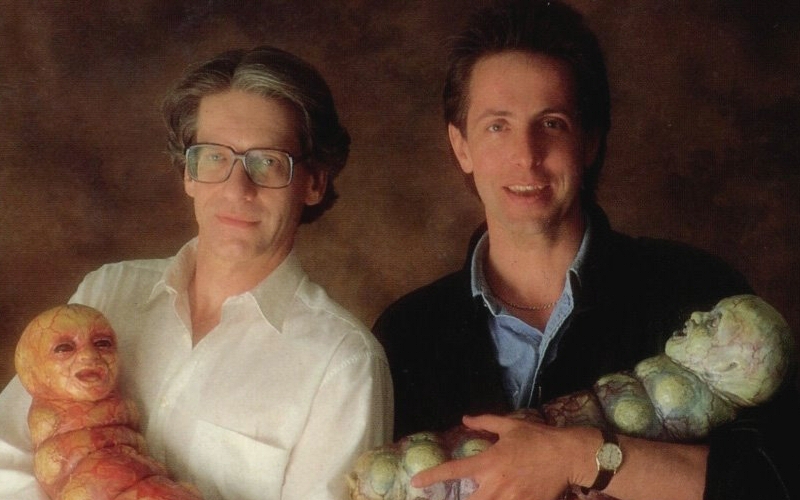
BODY OF WORK:
THE ACTiNG CAREER
OF DAViD CRONENBERG
~ by john cribbs ~
At the press conference following the Cannes premiere of his new film, Maps to the Stars, a tale of screwed-up movie stars in Hollywood, David Cronenberg insisted that actors "are desperate to exist; they're desperate to assert their existence." Which leads me to wonder what the director's turns in front of the camera say about his eXistenZ. The man who loves torturing his own actors with abdominal gashes, corrupting mutations and sexy car crashes has racked up 28 thespian credits over the last 30 years. Although most of them are limited to a couple lines, it's still an impressive number of acting gigs considering his respectable dozen+ directing projects over that time period. Now in his 70's, the Canadian king of renegade body horror is coming off one of his busiest years yet, having debuted his first novel, Consumed, on top of revitalizing a project that had been D.O.A. five years ago. With Maps getting its official U.S. debut this week, I thought it might be interesting to examine how the Toronto Terror's onscreen performances hold up, and what if any connection there might be between the films he appeared in for other directors and his own work.
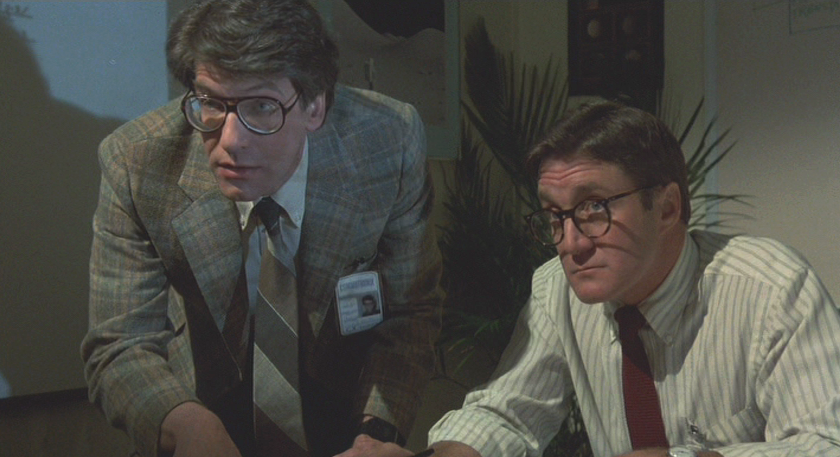
INTO THE NiGHT
john landis, 1985.
"Group supervisor"
A largely forgotten mid-80's effort from John Landis which arguably marks the point of decline for his once-prominent career. Moving forward, whatever small pleasures there are to be derived from Spies Like Us, Three Amigos!, Coming to America and Oscar, nobody could convincingly argue that he'd make anything as wholly essential as Animal House, An American Werewolf in London or Trading Places again. This one's no exception, but in its defense it also represents the last time Landis would attempt something that could even politely be termed audacious, albeit to ultimately unsatisfying ends (for more on that, see below). The movie has something going for it, but Landis fumbles through a basic lack of focus that may be attributable to the Twilight Zone Movie wrongful death trial that was going on while Night was in production (which doesn't explain the lack of focus that led to the deaths in the first place, but let's not get into all that again).
Jeff Goldblum goldblums it up as an insomniac industrial engineer whose shallow existence is coming apart at its fruitless seams: he can't sleep, his wife's been hosting another gentleman while he's at work and he can't remember the difference between the BPSK modulation scheme and the QPSK modulation scheme. He heads to LAX one night for some reason and ends up embroiled in the plight of Michelle Pfeiffer's plucky jewel thief, following her from one wacky scenario to the next. Basically what you've got is a madcap 80's bend on the ol' Hitchcock model of the timid everyman caught up in some sort of intrigue which happens to involve an impulsive blonde, a formula that would get a much more interesting shake-up in the surreal After Hours, released later the same year, and the following year's Something Wild.
Speaking of Something Wild, Jonathan Demme is one of several directors to appear in the movie, turning up briefly as an FBI agent late in the proceedings (Demme would later cast Roger Corman as a fed in Silence of the Lambs). Horror alums Jack Arnold, Rick Baker, Paul Bartel, Richard Franklin and Don Siegel can be spotted throughout the film, and we're treated to Jim Henson chatting on the phone with "Bernie" - get it??? (Landis had cameo'd as an asshole theatrical producer in Muppets Take Manhattan the previous year.) More than any of his cameo-happy productions, this one was heavily criticized as being over-indulgent to the point of distraction. My theory has always been that the number of Landis' movie buddies to appear in one of his films reflects his level of insecurity, that their presence makes him feel more legit as a director: a lower amount (American Werewolf, Trading Places) shows that the project is strong whereas wall-to-wall cameos typically signifies a disaster on scale of The Stupids. Into the Night features seventeen filmmaker cameos, possible evidence of his anxiety over the Twilight Zone circus as well as his uncertainty over how to make the movie work.
Among this collection of cameos is David Cronenberg, making his screen acting debut as a bigwig at Goldblum's aerospace company. His scene comes fairly early in the movie, before it lapses into complete chaos, and actually works pretty well. It's not overplayed, which is something that can't be said for the rest of the film. Cronenberg's signature monotone can be mesmerizing when he's saying something interesting, which is often the case (he narrated one of my favorite Stephen King stories, "Sneakers," on the Nightmares & Dreamscapes audio book), but you could see how it could put a classroom to sleep if the subject was anything less than fascinating. This uninspired drone is perfectly utilized to sap the energy out of a dark conference room with talk of full tolerance checks on buggers, sensors, corresponding transducers and smug ridiculing of a client's "god-awful" carrier tracking loop. He's basically standing in for Frank Oz, whose no-nonsense authority figures in The Blues Brothers and Spies Like Us contrasted the personality of the devil-may-care protagonists; here, Cronenberg is the anti-Michelle Pfeiffer, his banal recitation of dull facts spelling out what Goldblum can expect of his life if something in the form of a wacky blonde jewel thief doesn't send it in unpredictable directions.
Because Goldblum meets his partner-in-crime/romantic interest at LAX, I couldn't help thinking of The Morning After, released the following year. Writing about that film for Frustrating Filmographies, I complained that Sidney Lumet just doesn't belong in Los Angeles. Landis is right at home, but his approach to chronicling the outrageous nocturnal lives of hookers, derelicts, catty doormen, arty expatriates, Elvis impersonators, beachfront drug dealers and showbiz phonies is, like the casting of the filmmakers into these roles, a little too incestuous. The duo even stumble onto a movie set overseen by Cronenberg's fellow Canuck Daniel Petrie in a scene that's supposed to parody the self-seriousness of studio movie-making, but Landis is as much a hack as Petrie's character so the whole idea falls flat. Landis must consider himself more of an outsider than he really is - is the "madcap comedy" of his films not achieved by an ordered production peopled with dodgy teamsters, shallow actors and interferring studio heads? Who is Landis trying to send up, himself?
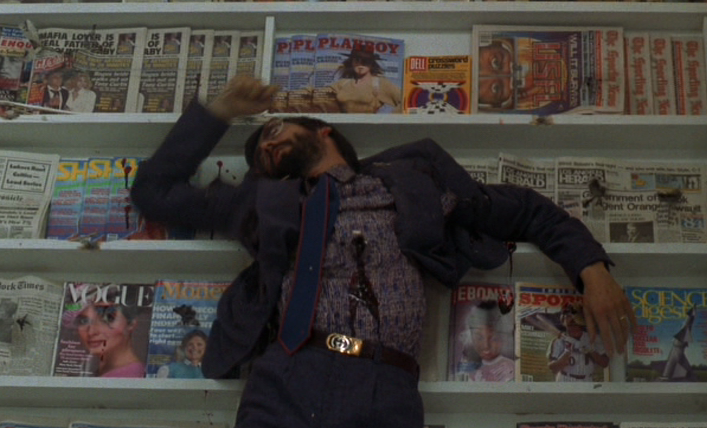
If that's the case, I guess the director's own extended cameo perfectly encapsulates the ambiguous region between Landis' rampant egotism and apparent self-hatred. He gets in on the action as a mute, inept Iranian thug (in brownface) who's constantly hitting his head on doors and walls, runs around pantsless at one point and is ultimately gunned down. Not many cameo-ing directors kill themselves off in their own movie (Oliver Stone in Platoon and Peter Jackson in Return of the King are the only two that come directly to mind), but this marks Landis' second screen "suicide" (after being hit by a car and thrown through glass in American Werewolf). His morbid sense of humor obviously hadn't softened in the wake of the Twilight Zone tragedy - almost insistently so, as if he had something to prove. The quartet of Iranian goons serve as the film's Keystone Cops, bumbling around in pursuit of Pfeiffer, yet there's a pretty brutal scene where they murder Kathryn Harrold, Paul Mazursky's beachhouse bimbo, by drowning her in the Pacific Ocean when she tries to run away. This dark twist of tone is the kind of thing that could have made the film really different, even a forerunner to the kind of black comedy found in Miami Blues or Pulp Fiction, but subjecting himself and his gang to constant pratfalls, Landis' film is just perpetually tone-deaf. At least there's a slight effort here: his subsequent films have been almost exclusively slapstick comedies with no hint of edge.
Glasses? Yes
Tie? Yes
Suit/vest? Suit
Shot in Toronto? Nope, California (Cronenberg may have been in town for pre-production on The Fly)
Relationship to cast/crew: Cronenberg cast Goldblum as the ill-fated Seth Brundle in his next film, The Fly (while Michelle Pfeiffer would go on to star in Married to the Mob for Cronenberg's fellow cameo-r Demme).
Cronenberg movie closest to: A nervous guy being led from one bizarre set-up to another by a giddy femme while people are trying to kill them isn't unlike the experience of Ted Pikul and the demoness Allegra Geller inside the eXistenZ game.
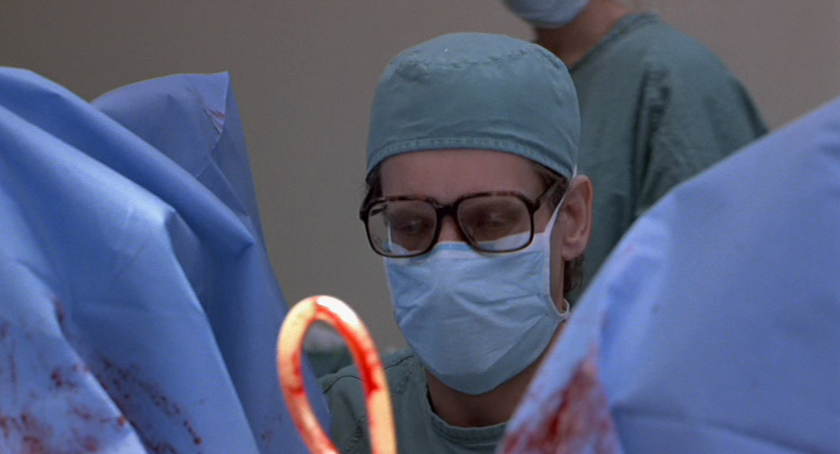
THE FLY
the man himself, 1986.
"Gynecologist"
On the first or second day [shooting Scanners], David Cronenberg said, "I had a dream last night." I then noticed that everyone who had been standing around walked away, except for me. He started talking about how in the dream, he was a praying mantis and he was eating himself, and kept vomiting. I said "Uh-huuh." The next day, he said, "You know, I had a dream last night" and a technician said, "What did you dream about?" And when everyone walked away, I went with them. You just don't want to be inside that man's head. - Michael Ironside
Did Cronenberg dream of Geena Davis giving birth to a writhing grub? I wouldn't be surprised - based on Ironside's account he apparently had insect metamorphosis on the mind a good six or seven years before directing The Fly. It must have been what compelled him to make his first (and last) extended appearance in one of his own full-length films. Previously he'd stood in for a stabbed shoulder in Shivers and for Max Renn when he's wearing the Image Accumulator helmet at Spectacular Optical in Videodrome (where's that action figure, Sideshow Collectibles?) Apparently, James Woods was paranoid about the helmet electrocuting him and refused to wear it, so that's Cronenberg under there. Afterwards he was in the background as an obstetrician in Dead Ringers and provided the muffled voice of the auto wreck salesman at the end of Crash, but to date his face and voice have never again been featured together in a feature-length Cronenberg movie.
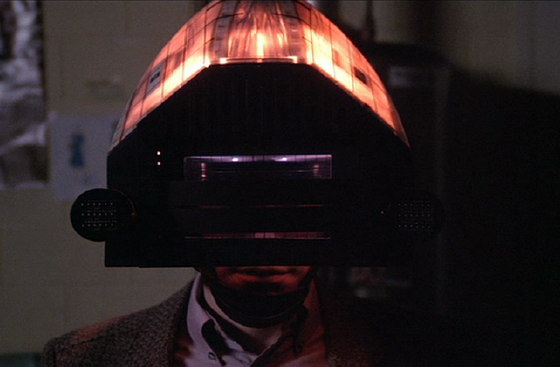
Actually his voice is slightly disembodied in The Fly, his mouth covered by a surgical procedure mask. It sort of prefigures a connection between Cronenberg's dream doctor and Goldblum's mutating scientist, whose mouth eventually falls right off - the last vestige of his humanity. One of the most frequent Cronenberg tropes from his earlier films was the well-meaning scientist who ends up creating monsters: Shivers' Emil Hobbes, Rabid's Dan Keloid, The Brood's Hal Raglan, Scanners' Paul Ruth. The Fly marks a huge transition in the director's work as the first film where the scientist is the main character, and he creates a monster of himself. As such, the director may have been compelled to remove (surgically, if you will) the reluctant B-movie mad scientist aspect of the character; the leftover Frankenstein-ness seems to have been shaped into the minor character played by Croneneberg. Although he doesn't have a hand in the birth of Brundlefly, he inadvertently brings forth the maggot that Geena Davis' Veronica Quaife fears a dipterated Jeff Goldblum has planted inside her, in circumstances that - albeit fantasized - resemble something out of an old B-horror movie.
The cameo was apparently inspired by Cronenberg meeting Martin Scorsese, who told him he looked like a Beverly Hills plastic surgeon (movie geek note: Tim Burton was originally attached to direct both After Hours and The Fly - Burton also included a nightmare sequence involving a doctor in a surgical mask in Pee Wee's Big Adventure the year before The Fly). After Dead Ringers, it's safe to say that Cronenberg wouldn't be most women's preferred choice of OBGYN, although here he's a lot less freaky than the flashy superstar gynecologists played by Jeremy Irons. And there's no trace of malignance like the evil Dr. Benway in Naked Lunch: he just seems like a responsible physician doing his job, rather impressively considering the size of that infant larva, seemingly conceived without the benefit of a c-section. This is actually one of his best performances: he nails that dreaded moment for any horror film heroine when he stops spouting encouragement at his patient and just stares blankly down between her legs. Although he's just a manifestation of Veronica's anxiety over giving birth, he pretty much sums up the kind of real-life biological horror that could befall any of us (in the semblance of a wriggling insect spawn).
Who knows if Cronenberg would have turned up again in the alternative ending as the doctor delivering the baby with butterfly wings.
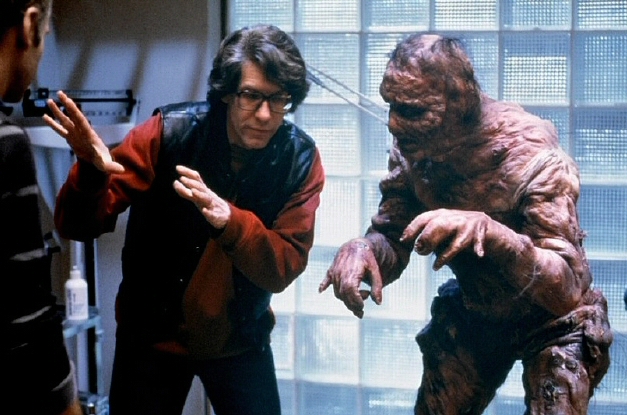
Glasses? Yes
Tie? No
Suit/vest? No, just scrubs
Shot in Toronto? Of course
Relationship to cast/crew: Cronenberg agreed to make the film under the condition that he could hire regular collaborators Ronald Sanders (editor), Carol Spier (production designer), Mark Irwin (dp) and Howard Shore (composer). It was his last film with Irwin, but Sanders, Spier and Shore are still part of his team to this day. Co-producer Mark Boyman would produce his next film, Dead Ringers.
Cronenberg movie closest to: Gotta go with The Fly.
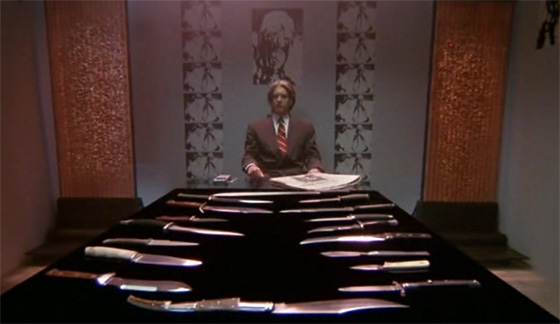
NiGHTBREED
clive barker, 1990.
"Dr. Philip K. Decker"
For Nightbreed, Cronenberg scored his meatiest and most celebrated acting role as Dr. Philip K. Decker, a psychiatrist-slash-serial killer who comes up with the clever scheme of planting the suggestion in the brain of one of his patients that maybe he's the one responsible for all these recent horrible murders. Because, you're crazy. Lucky for Decker, Craig Sheffer's gullible mullethead Boone buys into it (with the help of some LCD-laced lithium) even though his craziness has more to do with dreaming about monsters in a mysterious land called Midian than breaking into houses and brutally killing entire families. Decker also manages to sell the cops on this idea of Boone being a manipulative sociopathic murderer, despite the lack of any real evidence, to such a degree that they stage an impressive manhunt that ends with Boone being shot to death after Decker announces, "He's got a gun!" (of course they don't find one on the body - not at all suspicious, good work Decker).
Boone spurns the routine post-mortem agenda and instead joins the subterranean demon clique known as the Nightbreed under the cemetary at Midian, referred to as "Shangra-La on Dope" even though it more closely resembles the nondescript caves and tunnels and rope bridges beneath Pankot Palace in Indiana Jones and the Temple of Doom. Boone believes it to be a mystical place, but it's just an isolated graveyard somewhere in Calgary and the Nightbreed are terrible at not being seen - pretty much anyone who wanders in ends up meeting them. They have the impediment of being neither scary or funny: the combination of bad late 80's makeup design and an attempt to make them monstrous yet with cocky contemporary attitudes - one of them even channels the Beverly Hillbillies, saying "Y'all come back now ya hear!" after scaring away a "normie," another jokes, "No time for hootchie cootchie!" - results in them most closely resembling a society of sass-talking ninja turtles or the pot-smoking kangaroos from Tank Girl. (Is Howie Mandel's Maurice from Little Monsters a Nightbreed? Is Beetlejuice? I guess the nicest comparison would be to say the flippant 'Breed leads are kind of like non-badass Hellboys.)
I haven't read a single Clive Barker novel or short story, so maybe I'm missing whatever magical spark that's netted him so many fans - in terms of appraisal, I have only his cinematic efforts to go on. Hellraiser and Lord of Illusions are at turns cheesy and unrefined. Candyman's good, but that's easily attributable to above-average direction by Bernard Rose and a great performance by Virginia Madsen. Other adaptations of his work by different directors - Rawhead Rex, Quicksilver Highway, Midnight Meat Train - are largely (and mercifully) left out of larger discussions of Barker's work. Over the years I've tried to find something in Nightbreed to appreciate, since this is the one many claim best translates that Barker magic onto the big screen. It certainly has something on its mind, best detected in its efforts to decry monster persecution which has been equated by everyone (including the filmmaker) to a general misunderstanding and oppression of outsiders. Which is fine, except that there's little in evidence to tie the plight of the Nightbreed to any specific subculture: despite Barker's personal sexual orientation (and Craig Sheffer's glistening pecks behind an open leather vest), it's certainly not an excessively homoerotic horror film on par with Freddy's Revenge or The Nature of the Beast.
So we're basically left with a straight-forward "persecuted freaks" angle. While the "monster as hero" gimmick was a staple of celebrated comic books throughout the 1980's - DC's Swamp Thing and Etrigan the Demon, later Hellboy - those monsters actually did heroic things like journey to hell to save a loved one or settle Rasputin's hash. These Nightbreeds only defend their home by killing a bunch of cops in stupid ways like seducing them with their porcupine boobs and having snakes emerge very slowly from their stomach to attack anyone without the sense to simply back away. I guess it could have been cool, if the whole thing wasn't so unremittingly silly, and the message wasn't such a backhanded endorsement of outsider culture. "Listen guys - we know they're all icky and intolerable, but they deserve to live in their crypts and eat any humans who happen to come by...right? I know they're kinda gross, but maybe you could learn to love 'em?"
There's also just too much I don't understand. Aren't the Nightbreed demon-bred? How are Boone and Narcisse initiated? I know, by exposure to "the blood of Baphomet," but then are all Nightbreed mutated humans? What exactly are the Berserkers, the feral monsters short on catchphrases and big on mauling? Assuming they're Nightbreeders who've lost all their humanity, why do the intelligent 'Breeders even keep them around? Did Boone have to be bitten in order for him to come back to life (and if so, how does that explain Narcisse)? Or does simply desiring to be at Midian make you end up there after you die? How come Boone gets to switch back and forth between normal human features and monster-y pustules when none of the other 'Breed members exhibit this ability? And will he still be able to revert to "B-grade Boreanz" face now that he's become "Cabal?" If there's one thing I can't abide in a movie that insists on having lines like "The Tribes of the Moon embrace you," it's an ultra-shady mythology: they're supposedly innocent, yet thirst for human blood - the first thing Peloquin does is try to eat Boone. They allegedly can't be killed, but apparently you can kill some of them with bullets and fire, completely arbitrarily it would seem. Some can't go out in the sunlight, but others can. It's a lot like the Cenobites: neat concept, torture demons from hell or whatever, but the more background you get on them the more obvious it is that Barker never really fleshed out the background, or was willing to settle on "monsters - got it?"
Of course I'm sure this is all clarified in the recently-released director's cut of the film, 'cause it's definitely studio interference and not unfocused storytelling to blame here, right? Cronenberg had this to say about the movie being taken away from Barker in post-production: "I don't think I ever really saw what Clive had in mind, but it's a tough game and Clive sort of opted out of directing. And when I saw him, which was at a Stephen King event in Toronto, he was really bitter about his movie experience as he had quite a few bad ones."
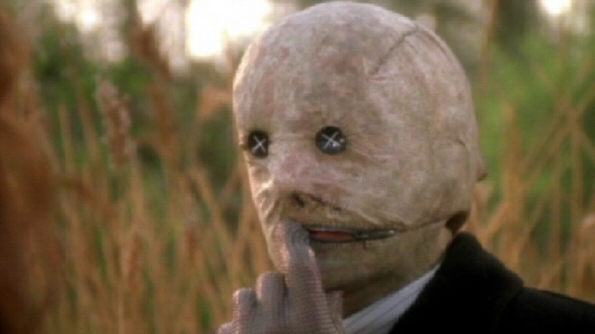
If the film has one saving grace it's Cronenberg's evil Dr. Decker, who states that "Everybody has a secret face" before he's revealed behind a burlap mask with button eyes and a zipper for the mouth (pretty badass but not very practical - how can he see?) He's a well-equipped madman, tooling about town in a mint green 1950 Cadillac convertible (I think this is the only time we ever see Cronenberg drive in a movie; we don't even know how he got to the lake where he meets Nicole Kidman in To Die For - does he just happen to live nearby?) and chilling in his own private knife room, sort of a Batman-meets-Bateman lair with a pair of those fountains with the water moving pretentiously up the walls instead of down (the sleek corporate version of a lava lamp or something). He racks up a pretty impressive kill count, offing 11 innocent people onscreen (including splatterpunk team John Skipp and Craig Spector, cameoing as corpses) and an undetermined amount of Nightbreed on top of setting Boone up to be killed. A townie at the local watering hole refers to a framed Boone as "baby-slasher," although it's never established as Decker's serial killer moniker.
Despite the novelty of David Cronenberg playing a slasher and his creepy performance, his character only brings up further questions. Why exactly does Decker continue to be obsessed with Boone after he's been killed and his body disappears from the morgue? Why would he jeopardize himself and his murder operation to keep insisting the police hunt down a man they already believe to be dead (certainly Boone, who doesn't know Decker is a serial killer, presents no threat)? And what was his plan in the first place, did he really intend to stop murdering families once the police were convinced they'd put the killer in the ground? Until he tortures an old timer played by John Agar for information (for what it's worth, the best scene in the movie), he doesn't know anything specific about the Nightbreed save vague recollections from Boone's dreams - has he fervently believed in them the whole time? How could he possibly?
And what does Decker have against the Nightbreed, other than the fact that they're sheltering Boone (which he shouldn't even give a shit about)? It's established that Decker has a problem with "breeders" (meaning your average heterosexual family) and states his killing spree is solely dedicated to cleaning up their "cesspools," but why should he care about a secret society that limits its activities (which include beating on the walls like STOMP or just hanging around with their heads sticking out of their abdomens) to an underground city beneath a graveyard that's in the middle of nowhere? Alejandro Jodorowsky, one of the only early defenders of the film, praised it for its obsession with the "unconsummated relationship between doctor and patient." So maybe Decker is jealous of Boone's new "family?" At the end, after he's killed and revived by the preacher with Baphomet's blood, it's implied that the two of them are going to team up against the Nightbreed in the no-chance sequel, but isn't he an initiated 'Breeder now? Aren't there a lot of evil 'Breeders who still stick with the clan? Lori randomly makes friends with a woman named Sheryl at some bar, then when Decker shows up at the cemetary Sheryl apparently knows him, trusting him enough that she walks over to him and is killed - is that just a huge coincidence? Ugh, I give up Clive Barker. It was probably a good call to opt out of directing.
Glasses? Yes
Tie? Yes
Suit/vest? Suit with trenchcoat
Shot in Toronto? No - Barker convinced Cronenberg to fly out to London for three months. Most of the film was shot at Pinewood Studios although some location shooting was done in Calgary (where the movie takes place). Barker then got Cronenberg to come to Los Angeles for an extra three days of reshoots to help clarify his character. (That must mean the John Agar scene, right? Was the best scene in the movie a reshoot?)
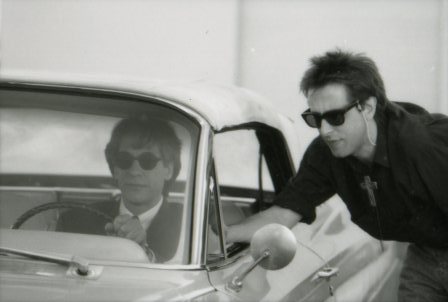
Relationship to cast/crew: Producer Gabriella Martinelli co-produced Naked Lunch and produced M. Butterfly (and was credited as production manager of Dead Ringers).
Cronenberg movie closest to: Cronenberg's not big on creature features, but Naked Lunch (the screenplay of which he wrote at a rented house in St John's Wood while working on Nightbreed) loosely parallels the story of a normal guy becoming immersed in a society of freaks, mutants and Mugwumps. It also featured a doctor as its psychotic antagonist.
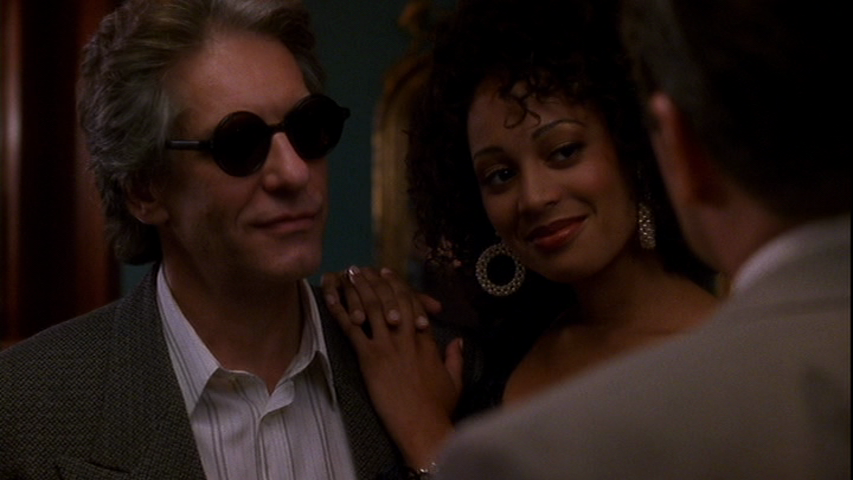
TRiAL BY JURY
heywood gould, 1994.
"Director"
After being featured in front of Don McKellar's camera in the short film Blue and in Boozecan, the directorial debut of the actor who played Frank Dodd in The Dead Zone and Hank in Naked Lunch, Cronenberg made a brief appearance in this film from the writer of Cocktail.* He plays a smirking, shade-wearing, undoubtedly coked-up movie director (possibly a send-up of himself?) accompanied by a hot floozie who congratulates Armand Assante's mob boss Rusty Pirone on his recent courtroom victory and confides that he'd like to make a movie about Rusty's glamorous mafia lifestyle. If he did, I hope to hell it would turn out better than Trial by Jury.
We're talking mid-90s, the apex of the John Grisham boom, when everyone from Joe Pesci to Rob Reiner was cashing in on the popularity of the tantalizing courtroom thriller (there was even a trial scene in Ghosterbusters II). As interchangable as these movies were, two films - 1994's Trial by Jury and 1996's The Juror (separated by John Fortenberry's Jury Duty in 1995) - were absolutely indistinguishable from one another due to nearly identical generic posters and incredibly similar plots** (neither of which involved a Jeopardy!-loving chihuahua). Trial by Jury stands out as being the last time Hollywood would attempt to foist Joanne Whalley on a fickle movie-going public, as well as her last theatrical appearance in which she was billed under "Joanne Whalley-Kilmer" (she dumped Val while he was busy ruining The Island of Doctor Moreau in Australia). My favorite performance of hers is still as Bob Peck's murdered ghost daughter whose vibrator he tenderly kisses in the original Edge of Darkness, and after seeing Trial by Jury it's apparent that the less Joanne Whalley you have in your movie the better.
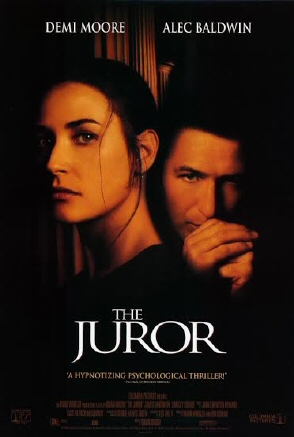
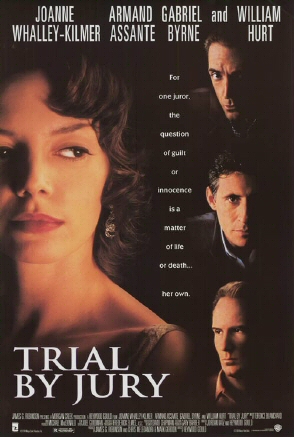
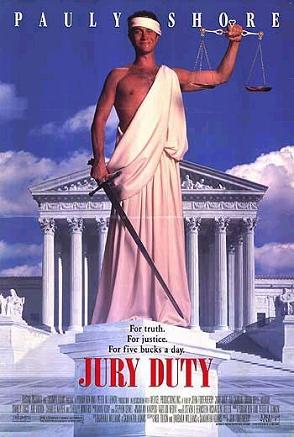
Actually I spent most of the film thinking how I couldn't believe Ashley Judd wasn't playing the Whalley role - it has all the ingredients of a dispensable late-90's Judd vehicle. Judd - I mean Whalley - plays a single mom who's selected for jury duty. She's nervous and excited about serving: she tells the doorman about it, she and her son discuss it on the ride to school, it's a controversy among her co-workers at the vintage clothing store she owns, she calls her dad to talk about it some more...there is just nobody in this movie who is not going to hear about how she has jury duty. And that's before she learns it's the trial of suave mob boss Armand Assante, a daper "boss of no bosses" who "falls into a sewer and comes out with his pants pressed." Assante just had the prosecution's key witness whacked by Kathleen Quinlan-disguised-as-a-hooker (why the D.A.'s office would approve a conjugal visit for their heavily-guarded star witness is anybody's guess).
The movie meanders through the routine "sustained!" and "overruled!" business with some cute tidbits about jury duty thrown in (no reimbursement for rickshaw rides!) until shifty ex-cop William Hurt begins pestering Whalley and turns the whole thing into Red Eye in a courtroom. Preying upon her proud commitment to civic duty, Hurt's people threaten Whalley's obnoxiously ingratiating son to get her to hold fast and force an acquittal. Assante even turns up at her apartment like a well-groomed boogeyman, threatens and (it's implied) rapes her after the prosecution coincidentally leaks a fabricated rumor to the press that the mob is leaning on one of the jurors.
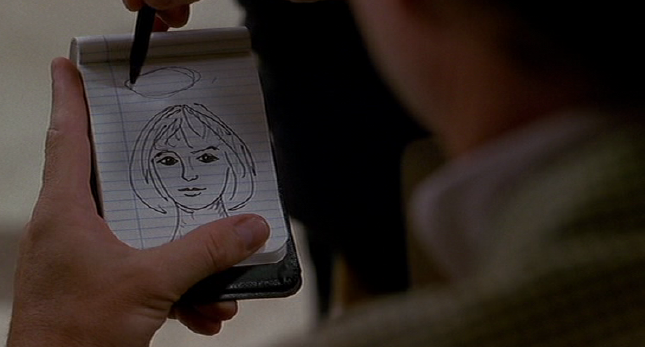
Like a wayward Henry Fonda, Whalley not only refuses to vote guilty but manipulates the rest of the jury with such tactless methods it's genuinely hard to tell if the movie suddenly turns into a satire of courtroom dramas or a cynical indictment of human beings in general. She falls back on phony judiciary arguments and moralizes about the defendant's constitutional rights. She uses her feminine wiles to bring one juror who has a crush on her to her side. She makes herself out to be a victimized woman so the other female member will back her up against the men. She alludes to the civil rights movement to sway a black jury member. The whole thing almost turns into a "Monsters Are Due on Maple Street" situation when a gay juror's rationalizing gets thrown back at him by a prejudiced peer. Whalley practically starts a riot within the sequestered room; even though most of the members see through her blatant sophistry, Whalley effectively hangs the jury and Assante goes free.
As entertaining as this ugly scene is to witness, the whole movie immediately spirals into an unfocused mess. Having tapped into a dark side she didn't realize she harbored, Whalley unconvincingly goes from terrified wimp to sultry femme fatale; thank god it's established that she owns a vintage clothing store, otherwise we'd no doubt be distracted wondering where she could possibly have picked up those old timey digs - thanks, movie! Quinlan also plays dress-up as William Hurt goes through kind of a Vertigo phase, making him think that she's Whalley and cockteasing him even though it comes out of the blue and it hasn't really been established that he's secretly into his victim (I guess since she pretended to be a hooker earlier we're supposed to accept that question that Quinlan is good with disguises?) Then there's the prosecution team, whose tactics are no less unscrupulous than Assante's - they also bully a gay man, a mobster who they threaten into testifying with a videotape of an illicit prison bathroom rendezvous. D.A. Gabriel Byrne even has his own tough-guy who doesn't mind breaking the law played the late, great Ed Lauter. Their efforts to find out how they lost the trial is a useless subplot (although I enjoyed seeing Byrne eat lunch in the courtroom, a big messy sandwich, then later sharing pizza with his team in the office while they wait for the jury to deliberate). The culmination of all this turns out to be absolutely nothing, especially once the sickeningly sweet son is returned home once Assante's been vanquished and announces:
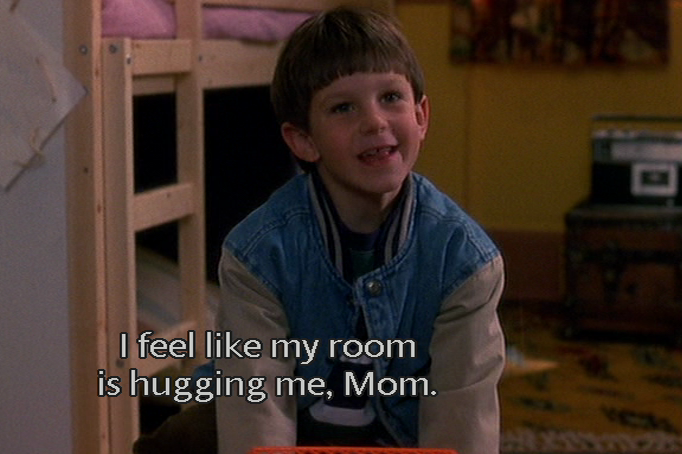
note the pink sheets: very progressive for 1994.
Whalley's character completely changing once she switches to evil mode could have been interesting (or at least more amusingly ridiculous) with a better script and more credible actress. You'd think she'd run with it, since Whalley more or less pulled off the post-modern NOIR victim/vixen role in John Dahl's Kill Me Again (and her sex scene in that with future ex-Mr. Whalley-Kilmer is dynamite) but she's not convincing as a Lifetime Network-style single mother martyr or confident manipulator. The whole transformation may have been easier to accept if it weren't incited by Whalley being threatened, humiliated and raped by Assante (did he rape evil into her?) The movie wants the audience to understand it's a harsh world in which amoral hot shots, embodied by Cronenberg's slick Hollywood phony wearing shades and a shit-eating smirk, walk all over the powerless, but can't come up with a better solution for its protagonist than to adapt said corruption for a convenient period before going back to being a noble single parent whose son may be suffering from early-stage manic claustrophobia. It's funny but not quite convincing for Whalley to waltz into Assante's mansion in a sleek dress borrowed from Veronica Lake, brutally stab him to death, then re-enter life with the assertion, "Now I'll be fine." Give me the exciting mob movie Cronenberg's character wants to make any day, especially if he takes Assante's suggestion to cast Rusty as himself: "I'll make you look good."
Glasses? Shades
Tie? Yes
Suit/vest? Suit
Shot in Toronto? Yes (with exteriors in NYC)
Relationship to cast/crew: Producer James G. Robinson (founder of Morgan Creek) was an executive producer on Dead Ringers and Nightbreed, line producer Michael MacDonald would later serve as co-producer and production manager of eXistenZ. Cronenberg would direct William Hurt to an Oscar nomination for his over-the-top performance in A History of Violence (which co-starred Peter MacNeill, who was also in Trial by Jury director Heywood Gould's follow-up courtroom thriller Mistrial).
Cronenberg movie closest to: M. Butterfly had corruption and courtroom scenes, dress-up and disguises, although the mob terrorizing a young woman and a helpless minor brings Eastern Promises to mind.
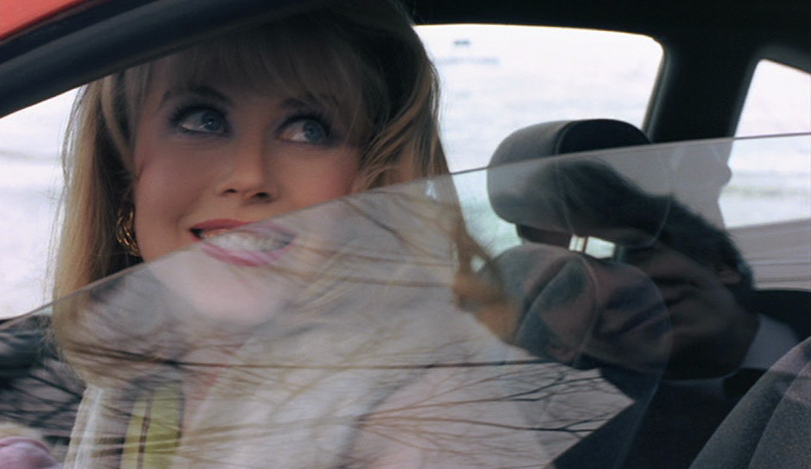
TO DiE FOR
gus van sant, 1995.
"Man at the lake"
Did you come all the way from Hollywood?
How appropriate for Cronenberg to follow up his Trial by Jury appearance as a hot shot movie producer who intends to cast a notorious mob boss in a movie about his own life by playing a mob hitman pretending to be a hot shot movie producer who intends to cast a notorious criminal in a movie about her own life. It's just too bad he isn't billed as "The Man from Hollywood," which would be a cool/ominous appellation for the friendly killer who escorts Nicole Kidman's Suzanne Stone to her icy grave under the frozen surface of a secluded lake (ooh, spoiler).
Gus Van Sant was new to Hollywood back in 1995: this film marked his move to the big time and a straight path to such mainstream mediocrity as Good Will Hunting and Finding Forrester (with a minor detour into one delightfully subversive shot-for-shot Hitchcock redux). In retrospect, fans of the director's earlier work may view Cronenberg's well-dressed assassin as symbolic of the studio suits who lured unsuspecting auteur Van Sant away from his true calling, effectively "freezing" his artistic vision. After all, there had to be a certain amount of identification with Suzanne Stone on Van Sant's part: as horrible and manipulative as she is, she's the only one in the film to show any sort of drive or creativity, always with her eye through a camera lens as she documents "hours" of a trio of the same sort of shiftless misfits who occupy Van Sant's early films. Was the director not himself documenting such unambitious existences as the two boys from Mala Noche, the hustler gang of My Own Private Idaho, the crew of addicts in Drugstore Cowboy? Indeed, Matt Dillon went from the independent outlaw of Cowboy to the loving and responsible yet dull and oblivious hinderer of Suzanne's career and victim of her wrath - Van Sant/Suzanne thought they were casting off the safety net en route to bigger/riskier projects only to be delivered into the gloved hands of Cronenberg's "Man from Hollywood."
Cronenberg was a logical choice to appear at the end of Van Sant's movie, filling the same kind of "kinky cult artist guru" role as William Burroughs had at the end of Drugstore Cowboy. Cronenberg's version of Naked Lunch also includes a mariticide and an attempt to document societal outcasts that ends with the murder of a woman by a well-dressed man in the middle of nowhere. But really, insofar as To Die For is a story about an individual who becomes consumed by media, and how it dictates her own (mainly deviant) behavior, it more closely resembles Videodrome. Suzanne isn't too far detached from the self-destructive Nicki Brand, whose apparent sexual appeal can only really "matter" if it ends up coming off the hot glow of the television screen. The line Suzanne cribs from anchorman George Segal*** sounds practically O'Blivion-esque: I believe that in our fast-moving computer age, it is the medium of television that joins together the global community and it is the television journalist who serves as a messenger, bringing the world into our homes and our homes into the world.
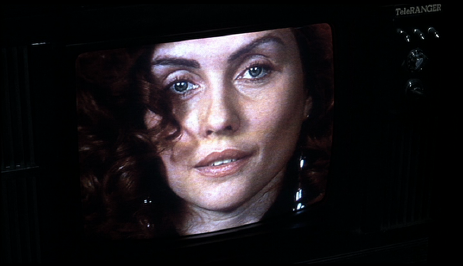
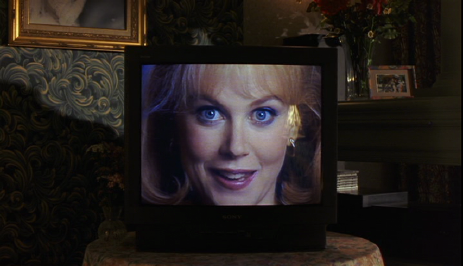
I may be giving To Die For a little too much credit. Van Sant is very grounded as a filmmaker, and the movie's snarky, incredibly broad satire is something he never seems particularly comfortable with, to the point that the film almost completely abandons that angle in the second half of the movie (minus a muddled attempt to bring it back to the foreground in the film's final moments). After the murder, Suzanne's story slips into a lulling examination of those she duped into carrying out the crime coming to terms with who she really is, which the audience is already well aware of, rather than following up on how Suzanne's self-sensationalizing is mirrored through her newfound media exposure (I know in the previous write-up I complained about the excess of court scenes in mid-90's movies but seriously, there's no court scene?) It's the first time Van Sant would film a story loosely inspired by a real life American tragedy (in this case, the crime of spouse-murdering media coordinator Pamela Smart), and while he'd perfect his approach with the redeeming "death trilogy" the following decade, there was no way to subvert the sheer amount of Texas Cheerleader-Murdering Mom style cuteness of Buck Henry's script.
The film works best when it focuses solely on Kidman's monomaniacal media-whore Suzanne. Shrewd, hard-working and brimming over with aplomb, she is every driven hopeful whose ambitions are waylaid by a complete disharmony with how things work in the real world. She's clearly too big for her small town but can't find a conventional way out of it and Van Sant, as I mentioned before, obviously sympathizes with her to some degree. Working against its grotesque characterizations, the best parts of the movie are empathetic moments, most notably the scene where Suzanne is struck dumb at the realization that her husband is never going to support her ascent to superstardom, that all his assurances of her becoming "the next Diane Sawyer" were empty, condescending encouragements in anticipation of her eventually succumbing to the allure of life as a dutiful homemaker with screaming crumbcrushers scurrying about underfoot. If Van Sant was going to find a way to commiserate with such a delusional, unrepentant, matricidal seductress of a heroine, it's at this moment which every artist dreads - the asphyxiating banality of domestic comfort. The next time we see her this lifelessly frozen, she'll actually be lifeless under a block of hard ice, all her ambitions permanently petrified.
It's funny to look back on the film now, 20 years later, and realize this was Kidman's first big star turn, the moment she broke out from being Mrs. Tom Cruise by playing, ironically enough, a woman who ditches her husband in order to get famous. So even the actress has a clear connection to the character, a woman destined to do "things ordinary people wouldn't do" who quite literally creates her own news (y'know, like Jonathan Pryce in Tomorrow Never Dies or the Channel Six "On the Spot" news team from Mr. Show). Something that doesn't get brought up much is that this was also when Illeana Douglas broke out from just being Martin Scorsese's girlfriend who popped up in small bits in his movies. Even though her semi-professional ice skater Janice Maretto is a sympathetic victim of Suzanne's horrible scheme, she's also something of a quiet monster, harboring a lot of the same resentments as Suzanne but lacking the confidence to do anything about it. Consequently, she also has a man commit murder for her (at least her family does) and becomes empowered by besting her enemy: notably introduced slipping on the ice, she skates like a pro in the final shot as she grinningly dances over Suzanne's grave.
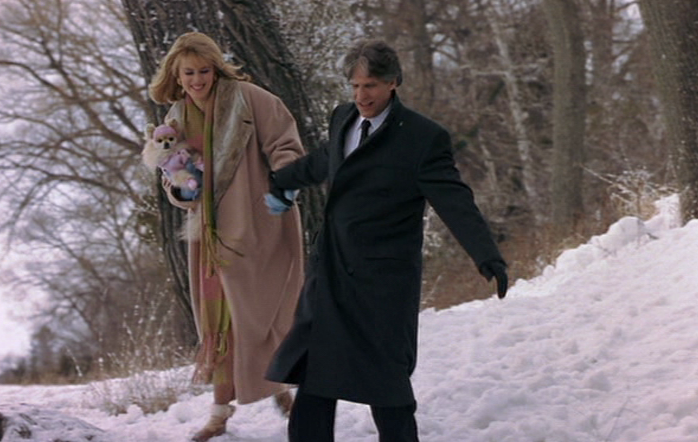
For his part, Cronenberg is effectively creepy and seems to be having a blast as he playfully leads Kidman down a snow bank onto the ice below the bridge. We know he's not just a heartless thug because he spares the dog (after politely greeting it) but he's not short on mundane menace, responding to Suzanne's declaration, "I thought you'd be older" by simply stating, "I am older." He affects a friendly attitude and winning smile that, complimented by the absense of his heavy spectacles, puts the viewer at ease even though we're aware of what's coming - there's a grisly flashforward shot earlier of the house/barn where he's leading her, over which we can hear the sound of Suzanne screaming. Afterwards he's seen calling Dan Hedaya to let him know the hit was a success - Hedaya should have called upon Cronenberg instead of M. Emmet Walsh to eliminate his target in Blood Simple (his target being John Getz from The Fly, a film in which he also tries to steal a curly-haired actress who married a film director from her companion, with similarly tragic results. Note to movie characters: don't get jealous and drunk when you suspect John Getz is trying to woo your lady...bad things will happen).
I guess you just have to accept how ignorant of reality Suzanne must be to buy into Cronenberg's barely-disguised true intention. I mean, I buy her being too apathetic to the circumstances of her "real" life to have caught on to Hedaya's mob ties during her one-year marriage (Dillon doubtlessly kept her in the dark about it, even though some local school teacher knows enough not to piss Hedaya off), but considering how efficiently she spun the web that got her husband murdered you'd think she had at least an inkling that something was seriously wrong with this scenario. I guess Cronenberg just sold her with that smile, but even still - where does she think this interview is taking place? At some executive office that can only be accessed by walking across a frozen lake? It's like Perry Caravello meeting the President of Show Business at the end of Windy City Heat.
At any rate, Cronenberg was the only man to successfully kill Nicole Kidman in a movie until John Cusack (co-star of Maps to the Stars) in 2012's The Paperboy.** ** Both murders occur off-screen.
Glasses? No
Tie? Yes
Suit/vest? Suit with trenchcoat
Shot in Toronto? Yes
Relationship to cast/crew: William S. Burroughs, author of Naked Lunch, had appeared in Van Sant's Drugstore Cowboy and Even Cowgirls Get the Blues. Pierre Trudeau, the Canadian prime minister whose 1970 invocation of martial law in Quebec during the FLQ crisis inspired the second half of Rabid, is mentioned by Kidman in the movie (in relation to unrelated Doonesbury cartoonist Gary Trudeau). Jennifer Jason-Leigh had her part recast in the Kidman-starring Eyes Wide Shut because she was committed to starring in eXistenZ when Stanley Kubrick wanted to do reshoots. Cronenberg would later cast Mia Wasikowska, who co-starred with Kidman in Stoker and played the lead hipster pixie girl in GVS's bellyflop Restless, in Maps to the Stars.
Cronenberg movie closest to: Videodrome (see above)
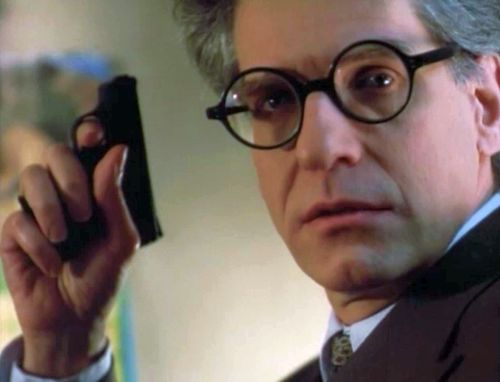
BLOOD & DONUTS
holly dale, 1995.
"Crime Boss"
And now he's like fluid?
The Canadians have their werewolves (Ginger Snaps), their zombies (the Resident Evil series), their scanners, their saws, their cubes and their paperboys. But up until last year's acclaimed Afflicted, the vampire wasn't well represented up north. When vampires did turn up in Canada, they were typically good guys like Forever Knight's Detective Nick Knight or Blood & Donuts' shy bloodsucker Boya, who loiters around a coffee shop in Toronto (no, not Tim Hortons) and ends up warring with some incompetent mobsters like Anne Parillaud in Innocent Blood.
Boya is one of those Anne Rice-ish romantic/philosophical vamps who says things out loud like, "I believe dreams are a dialogue between the mind and the soul." Believing that mankind inadvertently spoiled a big part of the universe's sacred mystery or something the day he set foot on the moon, Boya decided to hang up his cape back in 1969 only to wake up 25 years later when a golf ball shatters his window (pretty light sleeper for someone who's been comatose for a quarter of a century). He's not a sexy creature of the night like Brad Pitt - he's pretty scruffy. He takes a few baths throughout the movie, but always looks like he needs one. He doesn't seem to have any kind of agenda upon waking other than to simply bum around and eat the occasional rat.
I think Tom Hiddleston's suicidal, epicurean count in Jim Jarmusch's Only Lovers Left Alive proves that this kind of conflicted vampire is still popular in arthouse cinema: avoiding feeding off humans, content to lounge around his apartment admiring his collection of vintage guitars, yet still susceptible to primal virgin-biting urges. Even in mainstream cinema and literature, the fiendish seducer popularized by Dracula has been surpassed by the sensitive, baseball-playing clan of Twilight as the standard bloodsucker. I'm not sure the exact origin of the "noble" vampire as we've come to know him, although it seems that 80's comedies like Vamp, Vampire's Kiss and My Best Friend is a Vampire had as much to do with it as the heroes-sans-tans found in Near Dark and The Lost Boys. Blood and Donuts, which was released the same year as two movies that went a long way towards staking the "vampire comedy" (Dracula: Dead and Loving It and Vampire in Brooklyn), places the conflicted/noble vampire found in Michael Almereyda's Nadja from '94 (which featured a David Lynch cameo) and Abel Ferrara's The Addiction, also released in '95, in the middle of one of those comedic adventures that mainly draws humor out of other characters dealing with the existence of vampires. It definitely attempts the same kind of indie cuteness achieved by Jarmusch, Almereyda and Ferrara without the context of a supernatural situation.
I guess a quicker way to communicate all that would be to say the movie most reminds me of mid-90's guilty pleasure To Sleep with a Vampire, which also featured a goofball cab driver, although Blood & Donuts notably lacks Scott Valentine "sun-bathing" with a spotlight wearing tiger speedos and Charlie Spradling being constantly topless. It would benefit from being about 30% sexier and 50% funnier. Boya's love interest, the waitress at his new favorite donut shop played by Helene Clarkson, is a quirky philosophy student instead of a stripper, reading books on Shamanism behind the counter and wondering aloud whether if, with years of focus, a person could "do shit that would be impossible." (She and Boya do share a psychic masturbation scene.) For comedy it relies too heavily on Justin Louis' cabbie sidekick who speaks with an obnoxious accent, one in which he adds s's to the end of words ("Hows am I gonna finds you?") Sorry to offend Canadians from whatever province this accent is supposed to be from, but it makes an already kinda loathsome character completely intolerable. The same guy doesn't have that accent as Sarah Polley's husband in Dawn of the Dead, so I'm assuming it was an acting choice. A bad acting choice.
In terms of original spins on vampire mythology, I will confess this is the first time I can recall a vampire movie where the ol' stake-through-the-heart trick doesn't work. But Boya doesn't use it to his advantage: he's staked by a former flame who's found out he's back and been following him around, pestering his new potential girlfriend and making a general nuisance of herself. When she goes from stalking him to staking him, he should have pretended the weapon killed him: that way, she'd think he was dead and move on. Instead he immediately pulls the stake from his chest and chides her with a line about not believing everything she reads, thus assuring she'll turn up later to bug him some more. C'mon Boya, use your head.
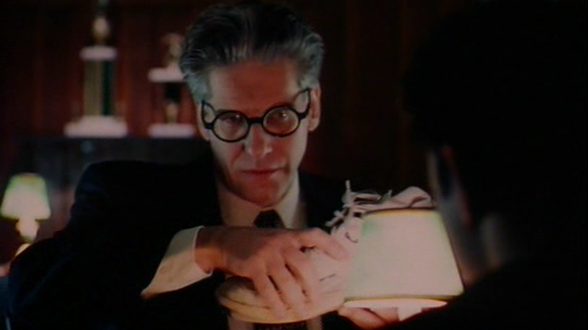
Meanwhile, Cronenberg - enjoying his first "and" credit - is an unnamed crime boss who hangs out handling Canadian currency in a bowling alley like Chubby Galasso in The Wanderers. He seems to have moved up in the mafia world since his days as an enforcer in To Die For, except for the fact that he's hanging out in a friggin' bowling alley. Needless to say, when he makes a flunkie remove his shoe so he can demonstrate the difference between the faint smudge it leaves on the wooden table compared to the notable scuff made by Cronenberg's massive cowboy boot - "Most people long to leave a mark. If it were just a question of smudges, they wouldn't need the bowling shoe rule." - it's not the most intimidating display of authority ever exhibited by a lead bad guy. Possibly referring to his TDF walk-on, he further admonishes the lackey for using the phrase "put on ice," since the henchman was born in Toronto and therefore shouldn't talk like an American gangster. He does have a memorable line that's a huge improvement over the disposable dialogue he's forced to recite in most of his appearances:
Am I employing retards? I have nothing against retards in general, I just can't afford to employ them. Unless I'm the retard - am I the retard??
At first focusing his evil attention to Louis' hack who owes him money or something, Cronenberg's interest shifts to the superhuman Boya, who he refers to as "the bat man." For some reason, it's never made explicit that Cronenberg is the one who hits the golfball through the window and wakes Boya up in the opening scene, even though it's clearly his silhouette lining up shots. If it is meant to be him, that's a pretty remarkable coincidence. Or perhaps Cronenberg was inadvertently setting his own death in motion, as the tiny gun he pulls on Boya proves even less effective than a stake and he meets a nasty end: the vampire removes his glasses, cuts the side of his face and feeds off him (even licking some up afterwards). His death scene is funnier, sexier and more disturbing than anything else in the movie - Louis is so bothered by it he falls out the window (hey, it really bothered him!) No reanimation for Cronenberg a'la Loggia in Innocent Blood; you won't be seeing him anymore in the bowling alley or on the golf course.
Director Holly Dale's only other feature film is a 2002 movie called Dexter that sounds like a spin on the ol' Zero for Conduct/if... boarding school rebellion plot. Weirdly enough, she went on to direct episodes of Dexter for Showtime. I couldn't really come up with what angle she was going for with this one - donut/sugar addiction sort of equivalent of blood addiction? - and, like Nightbreed, most of the scenes fall flat without Cronenberg there to make it interesting.
Glasses? Yes
Tie? Yes
Suit/vest? Suit and trenchcoat. He's arguably at his Cronenbergiest here, probably providing his own wardrobe. His outfit is straight out of a Naked Lunch publicity photo.
Shot in Toronto? Yes, and on the moon
Relationship to cast/crew: Frank Moore, who plays the more reliable of Cronenberg's minions, was Marilyn Chamber's boyfriend in Rabid (he was also in The Long Kiss Goodnight, which filmed primarily in Canada - no offense to Patrick Malahide, but Cronenberg would have made a great Leland Perkins). Hadley Kay (Axel) played a delivery boy in Dead Ringers. Justin Louis (now known as Louis Ferreria) was in Boozecan with Cronenberg. The film was written by Andrew Rai Berzins, who'd go on to write the horrible Beowulf & Grendel, which I only saw for Sarah Polley, who was in eXistenZ.
Cronenberg movie closest to: The nearest Cronenberg ever came to making a vampire movie was Rabid, although technically Marilyn Chambers is the only real vampire in that movie (her victims turn into mindless cannibals). His version of the vampire legend, as rampaging venereal disease spread anonymously without the carrier even being aware of it, is an interesting twist that hasn't really been explored further in movies. (Vampirism as disease was sort of the approach of Daybreakers, but it ended up being more about social structure.)
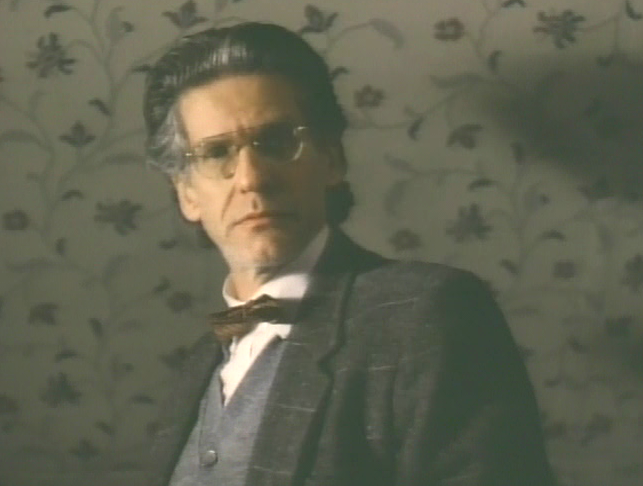
HENRY & VERLIN
gary ledbetter, 1996.
"Doc Fisher"
Remember that overwhelming demand in the mid-90's for a Canadian movie to mix together the most saccharine moments of One Flew Over the Cuckoo's Nest, The Boy Who Could Fly and Of Mice and Men? Wish fulfilled with Henry & Verlin, especially Of Mice and Men. I'm not even kidding - Gary Farmer's titular hulking simpleton literally strokes a rabbit at one point; if he could talk, I'm sure he wouldn't shut up about owning a ranch with a field of alfalfa. Since he can't/won't speak, he spends most of his time with his 10-year-old autistic nephew, who also can't/won't speak, and since Nintendo hasn't been invented yet the kid can't be enrolled in the Video Armageddon tournament in Los Angeles, so Farmer teaches him how to light fires and steal stuff and cozy up to Margot Kidder's one-legged prostitute who lives in a shed in the woods. For some reason, the parents disapprove.
Seven years of attending the Toronto Film Festival (where Henry & Verlin debuted in 1994 before getting a small release two years later), I've had to sit through several homebred Canadian movies during the slots lacking anything prestigious. And I can attest that, while mental illness is big among Canucks (Away from Her, Defendor, Cronenberg's own A Dangerous Method), autism is an even more popular topic, with the cinema of Canadia featuring more autistic characters than a Stephen King novel: Megan Follows in Under the Piano, Sigourney Weaver in Snow Cake, Kazan in Cube. Another thing I noticed about autism-based films in general is a common employment of the ampersand in their titles: Henry & Verlin...Mary & Max...Mozart & the Whale...The Fox & the Hound...Mike & Molly (you know, the movie where Elisabeth Shue is married to a fat policeman? She wants to be normal and he longs to be thin? Powerful, powerful stuff.) I thought Dominick & Eugene fell into this category until confirming that Tom Hulce is only mildly retarded in that movie.
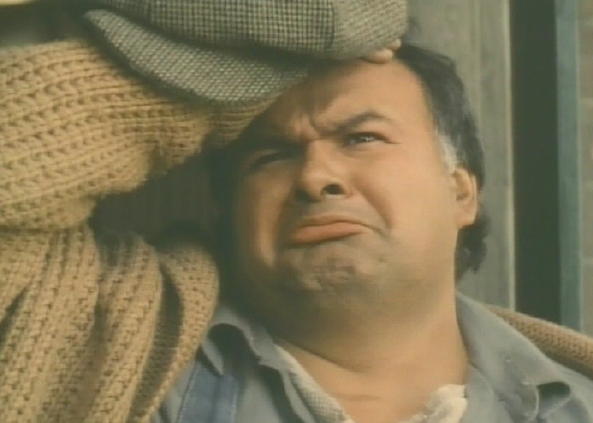
That having been mentioned, I honestly can't remember which of the main characters in this movie is "Henry" and which one is "Verlin." What I do know is that, to make sure he had all grounds covered, writer-director Gary Ledbetter gave both of his characters mental disorders. Gary Farmer, having already nailed the role of charmingly dim-witted frivolous spirit as Philbert Bono in Powwow Highway, is the mildly retarded one who never talks. The kid is the autistic one who never talks. The townsfolk try to keep them apart because they think it's not safe for the kid to pal around with Farmer. They are absolutely right: for one thing, Farmer doesn't think to duck when he walks through doorways with the kid on his shoulders, so the kid constantly sustains head trauma when he whams his head and crashes to the ground. Goddammit, Henry! Or Verlin! The burning question the movie asks, a full five years before I Am Sam, is whether a man with a developmental disability can care for a child without being judged by the greater torch-wielding community. A burning question I want to ask is why a bunch of bigoted assholes gang up to assault Farmer, a mentally challenged individual, because they believe he assaulted the kid, a mentally challenged individual. If one mentally challenged individual harms another, wouldn't that work in their favor? I guess they just need an excuse to beat up Farmer without hear of repercussion.
I mean I get it, it's about outsiders finding each other and bonding, kind of like Nightbreed except Farmer never scalps himself and Kidder doesn't have quills on her boobs.
Set during the Great Depression (yep, Canada felt it too), this may be the only period piece Cronenberg has ever appeared in, which is the only notable aspect of his presence in this film. What can you say about D.C. agreeing to lend his features to this project other than that he's a sweet guy to help out his friend and fellow Canuck Gary Ledbetter. Adapting a series of stories written by his father, Ledbetter doesn't shy away from sentimentality, painting rural 1930's Ontario with soft focus lighting that makes it look like A River Runs Through It if it was made for the Hallmark Channel and actually having a local physician character named "Doc Fisher." Instead of just having Graham Greene play the doc, Ledbetter picked on Cronenberg to come in for two quick scenes in which he tells the parents there's nothing physically wrong with the mute boy, making his cameo kind of like Jack Nicholson's in TOMMY with less atonal speak-singing. Considering his appearance as a doctor in The Fly, Cronenberg's Doc Fisher seems amiable enough; unlike certain doctors he makes house calls and seems reassuring even though he clearly has no idea how to deal with an autistic patient. He's just a little too mellow for Cronenberg - I'm not saying he always has to play a bad guy, but since he kind of naturally brings on the creeps there should be some hint of maliciousness in the characters he plays. Another doctor, a less comforting but not necessarily evil one at the sanitarium where Henry and Verlin end up, would have been a much better part for him to play: they even made the actor look like Cronenberg:
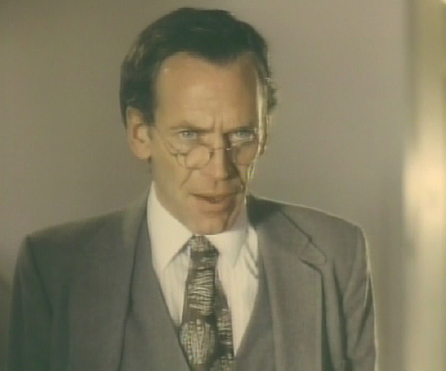
Is it obvious I don't have much to say about this movie? Cronenberg being in it made me think of Zelly & Me, another forgotten, ampersand-utilizing period piece (Zelly being set in the 1950's) by a one-time director you've never heard of (Tina Rathborne) that features a much more famous director reputed for his freakiness (David Lynch) in a top-billed supporting part playing the straightest role imaginable. Obviously, Lynch got roped into appearing as Willie the chauffeur by then-girlfriend/Zelly star Isabella Rossellini (although it would certainly be interesting to learn the opposite was the case), which makes me wonder if Cronenberg was dating Margot Kidder at the time of H & V. She used to date Pierre Trudeau, the Canadian prime minister shouted out in To Die For, and Brian DePalma, so we know she's into Canadian celebrities and directors. Kidder's handicapped hooker with her wooden leg isn't quite as kinky as Rosanna Arquette's steel braced Gabrielle from Crash, released the same year, but I'm not saying abberant kicks couldn't be had with a conveniently-placed termite hole.
Watching the film's preview, I thought the voice of the narrator, who describes the movie as "a story beyond words," sounded suspiciously like Cronenberg. It would have been hilarious if he was the one delivering such sentimental narration over softly-lit shots of gently-swaying wheat fields and babbling brooks like he was Mark Elliot. But listening closer, it's definitely not Cronenberg, so I was disappointed on top of being pissed off that the 4 minute preview is literally the entire movie, including a Doc Fisher scene - I could have watched that and saved myself 90 minutes.
Glasses? Yes
Tie? Yes
Suit/vest? Vest
Shot in Toronto? Rural Ontario
Relationship to cast/crew: Ledbetter worked electric on Dead Ringers. Moonshine Highway, a television movie directed by Andy Armstrong (action unit director and uncredited stunt coordinator for Nightbreed) which was shot in Ontario and released the same year also co-starred Gary Farmer and featured a Cronenberg cameo as "Clem Clayton." (I couldn't track down a copy of it to write about for this article - hope that doesn't damage the credibility of the whole venture.)
Cronenberg movie closest to: Cronenberg doesn't cast kids too often, but child welfare is certainly the hot topic of The Brood. Candice Carveth is near-traumatized by the painful separation of parents Frank and Nola and subsequent assault by the titular squad of navel-less mutant dwarfs. Well-intentioned yet harmful Hal Raglan and his Somafree Institute aren't terribly dissimilar to this movie's sanitarium, except of course for the total number of mutant dwarf-bludgeoned kindergarten teacher corpses as a byproduct of treatment (The Brood: 1, Henry & Verlin: 0).
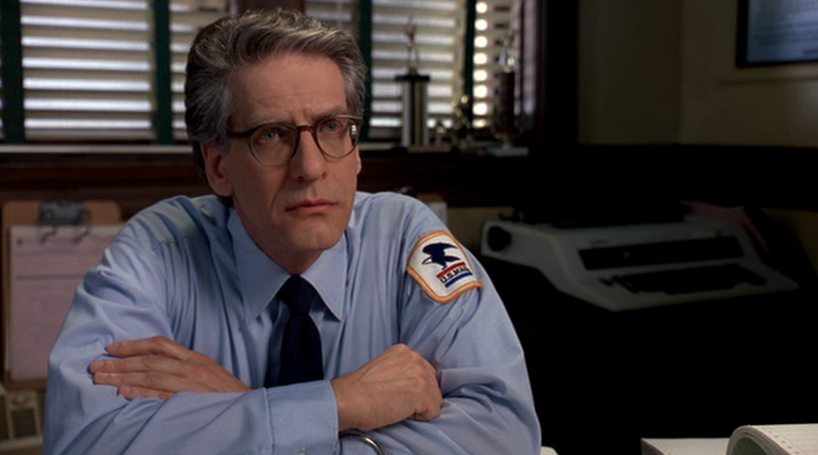
THE STUPiDS
john landis, 1996.
"Postal Supervisor"
Here's a little film nerd trivia for you: what do the directors of Z, In the Hear of the Night, West Side Story, The Battle of Algiers, Naked Lunch and Bend It Like Beckham all have in common? Answer: Jenny McCarthy. Specifically, they all appear in The Stupids.
Apparently, Jeremy Irons felt so robbed of an Oscar nomination for his dual performance in Dead Ringers that two years later when he picked up the prize for Reversal of Fortune, he gave David Cronenberg a special shout-out in his acceptance speech. Cronenberg responded by reteaming with his leading men, this time utilizing only one Jeremy Irons in M. Butterfly. The results were less critically and commercially positive (even though it's a good movie). Point is, Cronenberg may err in judgement when desiring to repeat a positive filming experience - at least, that's the only reason I can think for him to sign on for a cameo in a movie called The Stupids, that he had a blast on set with Jeff Goldblum in Into the Night and decided he was up for yet another John Landis debacle.
But Tom Arnold is no Jeff Goldblum. Or, more applicably, he's no Dan Aykroyd, a fellow portly comic who appeared in Cronenberg's scene from Landis' earlier film. Aykroyd, a six-time collaborator of Landis', managed to stay away from The Stupids in a year that saw him mugging it up in such underwhelming efforts as Celtic Pride, My Fellow Americans, Getting Away with Murder, Feeling Minnesota and Sgt. Bilko. The following year he'd find redemption from this glut of stinkers that have since lapsed from audience memories with Grosse Pointe Blank, by far his finest late career role. The same can't be said for those involved with The Stupids, most of the main cast having since fled to harmless television appearances in fear that they'll invite the stink of The Stupids onto any big screen they happen to grace.
There's every indication that a successful comedy could have been carved from the serise of books written by Harry Allard and illustrated by James Marshall. I love Marshall, especially the Fox and George and Martha series, and together with Allard he created such classics as Miss Nelson is Missing! and I Will Not Go to Market Today (one of my favorite books to read to my daughter). I never really got into the Stupids books, but they were nothing if not conceptual: one book is based on the entire family thinking they've died because they wake up and all the lights are out. There are some attempts by the movie to replicate this more abstract approach to the depiction of a socially and culturally oblivious family with the apt surname of "Stupid," though for the most part it's firmly stuck in Baby's Day Out territory with Arnold's family head Stanley Stupid running afoul of a secret military weapons project, which leads to fluke escapes from one inept assassin after another. This approach wouldn't necessarily have been an instant dealbreaker - such 90's comedy hits as Dumb & Dumber and the Naked Gun series, not to mention forerunners like interminable line of Pink Panter titles, were able to milk the hell out of their hapless heroes' "dumb luck" stumbling upon hijinx (Stupids was no doubt chasing some of that sweet Dumb & Dumber money). But Landis' movie is just too lazy to even set itself up for failure.
For example: there's a scene where the Stupid children, searching for their nincompoop of a patriarch, have gotten into the office of a major newspaper. Rationalizing that the computer can find their father if they offer it a photograph of Stanley, they feed his image into the hard disk drive of the hull. Perfectly fine joke I guess, ha ha that's not how computers work. Yet somehow by inserting this piece of paper into a device that reads digital data, the result is that 1) the computer copies the image of Stanley into the headline of the front page banner the previous user was working on, and 2) all the rest of the computers in the office short circut with dramatic sparks and shutdowns as befuddled newspaper employees leap from their cubicles in shock and alarm. Now - what?? Where is the simple A to B logic that a hard disk drive acts as a scanner that automatically places an image exactly where it needs to go in the system when you jam it into a random slot? Even moreso, how does such an act fry all the rest of the computers in the office? There's a detached logic to it - misusing a computer causes a complete system crash like when Corey Haim hits his screen in License to Drive - but come on, jokes have to at least exist in the realms of probability in order for them to work. The screenwriter of The Stupids, Brent Forrester, wrote the flawless "Lemon of Troy" episode of The Simpsons and co-wrote (with Dino Stamatopoulos) "The Audition" and "Pre-Taped Call-In Show," both shoe-in candidates for the coveted distinction of greatest Mr. Show sketch of all time. It's typical of Landis, whose sense of comedy is forever stuck in the days of the 1920's, to not give a shit if his set-ups make any sense but it's too bad Forrester couldn't come up with a funnier payoff to an already labored build.
I mentioned earlier how the number of cameos in any given Landis film marks the director's level of insecurity. The Stupids, with eight director appearances, is certainly no exception to the rule, and also underlines another characteristic of Landis' insecurity: repetition. And I don't just mean the relentless amount of egotistical self-referencing (did I even have to look at Mark Metcalf's name tag to know that his character was "Colonel Neidermeyer?") Following Coming to America (which he self-references into a forced, albeit amusing, connection with Trading Places by having Ralph Bellamy and Don Ameche reprise their characters), Landis would return to the well by doing another sketch comedy (Amazon Women on the Moon), another horror-comedy (Innocent Blood), another epic Michael Jackson video ("Black or White"), another Eddie Murphy vehicle (Beverly Hills Cop 3) and another Blues Brothers movie (Blues Brothers 2000), all more or less roundly rejected by audiences. His take on The Stupids taps into the same "pair/trio/family of boobs stumble into saving the world" basis of Spies Like Us and ¡Three Amigos!, complete with Spies' government/weapons intrigue. Of course the John Fogerty Rule dictates that any artist is welcome to return to the well in the latter stage of their career, but Landis exchanges any spark of originality for the comfort of in-jokes, reprocessed ideas and self-assuring presence of such luminary filmmakers as Robert Wise and Gillo Pontecorvo.
That said, Landis once again makes good use of Cronenberg, if you're willing to really delve into the nuances of a 30-second walk-on (in which Cronenberg doesn't even walk on, he's just sitting at a desk). The film's plot, if you can call it that, involves Stanley's belief that the postal service is part of a massive conspiracy to steal people's mail for an evil mastermind named "Mr. Sender." His suspicions are seemingly confirmed when he brings these concerns to his immediate supervisor, played by Cronenberg, and is promptly fired. Casting a creepy Cronenberg as such an innocuous figure as a mailman is fiendish on its own; having him represent the intangible corporate presence that runs the postal department (because really, who takes our mail? why do we trust them? what do they want from us?) is as perfect a use of his impenetrable reticence as channeling his professorial stodginess in Into the Night. Considering the suddenly sinister portrait of postal employees following incidents of disgruntled mailroom workers in the early 90's, you believe that a man like Cronenberg would have no trouble making his employees "go postal." So one thing you can say for Landis is he knows how to use David Cronenberg in any given situation.
Cronenberg has two lines: "Come in" and "What is it now, Stanley?" Both are about as funny as anything else in the movie.
Glasses? Yes
Tie? Yes
Suit/vest? No - standard postal uniform
Shot in Toronto? Yes
Relationship to cast/crew: Set decorator Carol Lavoie also did To Die For. Hairstylist Carol Marinoff was assistant hair stylist on Crash and Spider. Second assistant director Simon Board got his start as third assistant director on Naked Lunch and M. Butterfly; trainee assistant director Kerric Macdonald began her training on Trial by Jury. Fellow cameo-r/talentless hack Mick Garris (co-writer of The Fly II) had interviewed Landis and Cronenberg (along with John Carpenter) on a panel called "Fear on Film."
Cronenberg movie closest to: Cronenberg's only "family" entertainment - also featuring a dad, a mom, one boy and one girl - is A History of Violence, and the two film's cardboard-y portrait of a blissfully ignorant American family suddenly under threat in a small town is really not that different. The idea that there's something going on beneath the surface of Norman Rockwell-esque middle America is reflected in both Tom Stalls' dirty past and Stanley Stupid's belief in the conspiracy to steal unsuspecting citizens' trash and mail. For an unintentional emphasis on that connection, just check out the two mailboxes. And quality-wise let's be honest: the two movies hobble close to a pathetic dead last on both director's filmographies.
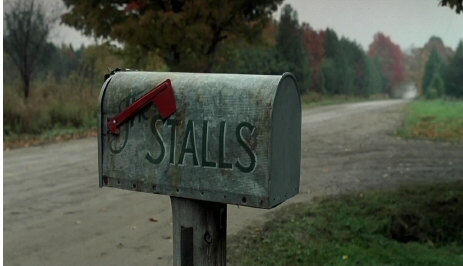
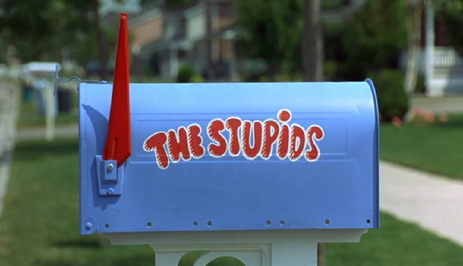
Combined Career Awards for Directors Cameo-ing in The Stupids:
13 Genies
1 César
1 Golden Lion
1 Palme d'or
1 Best Director at Cannes
1 Independent Spirit Award
2 Irving G. Thalberg Awards
5 Oscars
5 Oscar Best Director nominations
8 DGC Awards
2 DGA Lifetime Achievement Awards
1 Adult Video News Award
Combined Career Awards for John Landis and Jenny McCarthy:
1 Primetime Emmy
1 Daytime Emmy nomination
2 Razzies
7 Razzie nominations (including Worst Director for The Stupids)
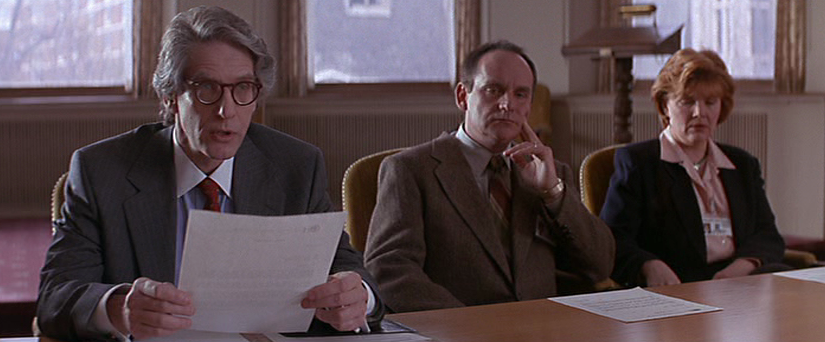
EXTREME MEASURES
michael apted, 1996.
"Hospital Lawyer"
Well, that was quick.
So says Hugh Grant after being read the terms of his dismissal from Gramercy Hospital, where he works as a handsome ER doctor, by lawyer David Cronenberg. Grant's referring to his abrupt termination after having a giant bag of pharmaceutical cocaine planted in his apartment, but he might as well be talking about Cronenberg's appearance in the movie, which consists of him spouting off one extended bit of corporate legal talk where he strips Grant of his duties and credentials and threatens to deport him, all in one close-up before the plot moves on. So that's consecutive appearances where Cronenberg's got about a minute worth of screentime, has essentially one line (although here it's a long line) and plays an authority figure whose involvement leads to the main character losing his job, both heroes erroneously believing his firing to be the direct result of a massive conspiracy. The conspiracy actually exists in Extreme Measures, but we find out at the end of the movie that Cronenberg's lawyer and his fellow members of the disiplinary board weren't actually in on it. Which in retrospect must have made Grant feel a right nob for pointing fingers at the board members and accusing them of spiriting homeless men off the street and into secret labs for freaky medical experiments.
Directed by Michael Apted between the goofy Nell and the terrible James Bond outing The World is Not Enough, Extreme Measures is a two hour chase movie that shoehorns an argument re: the ethics of using human guinea pigs in radical medical experiments into its final 10 minutes. It opens with a bedraggled homeless guy running from pursuers, like Hard Target (the set-up was so similiar I wondered for a minute if they had even hired the same actor and had him wear the same outfit). He ends up in Hugh Grant's hospital but disappears while being transported upstairs, piquing Grant's curiosity. Having worked with ER doctors for several years, I can tell you that if a dead derelict fell completely off the map and the doctor wasn't required to follow up on the case anymore, he'd be more than content (I don't say that to be mean, they're just very busy people). However, Grant won't take no for an answer and turns gumshoe, his amateur investigation leading him to Gene Hackman's hot shot neurosurgeon using live test subjects to find a cure for paralysis, the kind of functional underground society of homeless people you only find in movies (of the non-C.H.U.D. variety) and the revelation that pretty much everyone (except David Cronenberg) is doing everything that can to keep his gorgeous lips sealed!
His main stalkers are David Morse and Bill Nunn as a fed and an NYPD detective named Burke & Hare (ha! nice one, Tony Gilroy) who've been converted to Hackman's cause (they both have relatives in wheelchairs). Some of the nicest moments in the movie are between these two reliable character actors - in one scene, they're going to follow Grant to another homeless guy who escaped, but Grant on his motorbike unexpectedly goes the opposite way down a one-way street. Morse and Nunn are forced to punch a u-ey and slam on the brakes when a garbage truck pulls out in front of them: Morse gets out and yells at the garbies, then frustratingly insists "I'll move it!" and gets into the driver's seat of the garbage truck. It's a weird moment with these characters where you really feel their frustration and annoyance at having to follow this oblivious doctor around. Also it's impressive that Morse knows how to drive a garbage truck (must be Character Actor Memory from playing a garbageman in some other movie - he must have, right?)
The way these two frame Grant makes no sense, however. They break into his apartment, toss the place and plant the drugs. The cops respond to a call about the break-in and, while they're waiting for Grant to return, happen to find the coke (there's some line about how it's legal for them to search the apartment if it's a crime scene or something). Why isn't Grant's immediate reaction along the lines of, "Uh yeah - my apartment was broken into. Remember, it's why you're here? So how is it not your logical conclusion that whoever broke into my apartment stashed the illegal drugs? I'd like you to please fingerprint that bag of pharmaceutical cocaine or find some other way to prove that it's mine, otherwise you can apologize and break that bad boy open so we can get the party started up in here." (Incidentally, uncovering the conspiracy doesn't clear him from the possession charge in any way, I wonder if he ended up having to go to jail for it?)
Based on a book by Michael Palmer, a second rate Robin Cook (ouch - that literally is the worst thing to be, isn't it?), the adapted screenplay is an early effort from Tony Gilroy, whose acclaimed Michael Clayton was all about the corporate world of lawyers and also employed two rogue hitmen following the handsome lead actor around, planting drugs in people's apartments and ultimately botching an assassination which uncovers the whole conspiracy. Makes me wonder if Cronenberg's character iworks for the same NYC law firm as George Clooney's - that would have made a funny in-joke cameo for him to be among the faces at Sydney Pollack's party. Beyond that, Extreme Measures is another case, like Henry & Verlin, of Cronenberg being cast in the wrong part. I guess if it was important to make the audience believe Grant's hospital was involved in all the bum-napping, Cronenberg's cold presence would be a good mislead, but it really doesn't matter that much. He would have been better utilized as a straight-up villain. There are a number of unethical doctors involved in Hackman's scheme, so even if Apted didn't want to cast Cronie as the lead baddie he should have at least been the one who tricks Grant into thinking he was paraplegic - let J.K. Simmons play the lawyer!
Not sure whether this has anything to do with anything, but it's interesting that Margot Kidder had her much-publicized manic episode where she disappeared for several days and turned up living like a derelict in someone's backyard around the time Henry & Verlin came out, and Hugh Grant got caught getting head from that hooker around the release of Extreme Measures. Just weird parallels to their respective films, Kidder struggling with mental problems in real life while Grant got involved with a street person in New York...maybe he should have told Jay Leno he was saving her from crooked cops who wanted to take her to a secret lab for non-consensual spine surgery. Right after the blow job.
Glasses? Yes
Tie? Yes
Suit/vest? Suit
Shot in Toronto? Yes, with exteriors shot in NYC.
Relationship to cast/crew: Special effects were by Dawn Rivard, who did Crash and eXistenZ; special effects coordinator Daniel White worked on eXistenZ and Spider. Dolly grip Hugh Brule was Best Boy on Naked Lunch. Stunt coordinator Rick Forsayeth did stunts for The Dead Zone. Danny Elfman did music for this and Nightbreed.
Cronenberg movie closest to: Radical surgery that leads to city-wide terror and a government cover-up has echoes of Rabid, although the attempts at cover-up and suffering of former patients more closely resemble the neuro-tampering hijinx of Scanners, with Gene Hackman standing in for Patrick McGoohan.
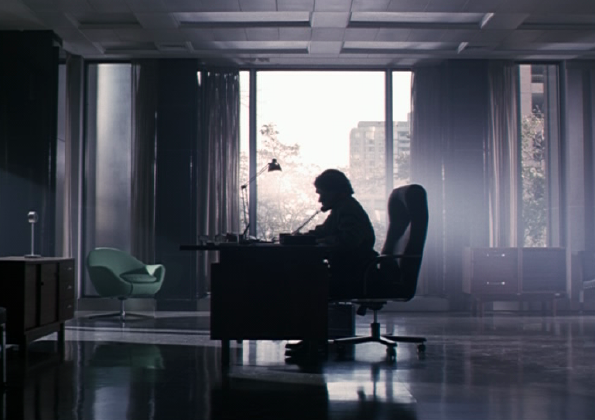
LAST NiGHT
don mckellar, 1998.
"Duncan"
Last Night is by far the best film by another director to which Cronenberg has lent his acting chops, the only one that could be counted alongside several of his own movies as a bonefide masterpiece. The set-up is so perfectly simple: a "last day on earth" drama with no asteroids, no explosions, no newscasts of natural disasters across the globe, no last minute redemption. Just a story of a city of people who all know life is going to end in a few hours and how they decide to spend them. What makes it great is that writer-director-star Don McKellar depicts the characters' activities as almost completely mundane. People go to work. They hook up and have sex. Young folks rally together for a party at Nathan Philips Square. Sandra Oh has a really bad day where nothing works out right. A final visit to his childhood home is just going to bring up the same sort of familial resentment as any other visit on any other day for McKellar. ("Would it hurt you to play along just once?") The result is a movie that's more about people living than maybe any other movie I've ever seen, a non-specific snapshot of existence at a very specific time (the film is undeniable 90's) made profound by its distinct lack of profundity.
As Ian Loffill so beautifully summarized, the film quite unobtrusively observes how people cope with inevitable nonexistence, and what compliance and defiance in the face of a hopeless situation can bring out in people. McKellar's character is the film's most seemingly apathetic, as if denial over recently losing his wife has extended to an overall repudiation of what's going on. Callum Keith Rennie's successful bucket list of long-gestating sexual conquests make you wonder why such lofty ambitions never occurred to him prior to the safety blanket of an impending void. Arsinée Khanjian, crippled by despair on a streetcar, could be any clinically depressed individual who wakes up one day to find they can't get out of bed or open the door. Even more identifiably, Sandra Oh's justification for ending her own life just before the cataclysm is the same argument I've often considered when contemplating suicide (not my own suicide, just a rationale behind the concept in general), which is the need to control one's fate rather than giving it up to the indifferent design of the universe. To Oh, all that's important is that she maintain some kind of command of her station, a resolve that's frustratingly and sort of hilariously compounded by the events of her last day (car stolen/upended, husband refusing/unable to respond to her repeated calls, circumstances confining her to an unfamiliar part of town/apartment). Her refusal to accept death - with death - is a wonderfully perverse way of saying that if something terrible's going to happen to me, it's going to be on my terms.
The only character to actually die before the end of the world/movie is David Cronenberg's senior administrator of the gas company, apparently named Duncan. Duncan has spent most of the day at his desk in an empty office, moving down an alphabetical list of clients, calling them one by one and leaving the same friendly message assuring the customer that their gas will stay on to the very last minute of Earth's existence. McKellar couldn't have selected a more perfectly absurd task to demonstrate someone's benign duty to routine: Duncan's messages often echo through empty households
At the same time, it's the most modest rallying cry to let the world know he still exists, that what he does is going to matter right up until it doesn't anymore. Mentioned by Chris Funderburg in his 200 Days 200 Movies entry, his adherence to a position absolutely no one expects him to continue filling marks the difference between mindlessly attending a job from one day to the next and taking such pride in what you do that even something as ultimate as the end of the world doesn't make it less important, even though in just a few hours it will conclusively make no difference. And if that's the case, then why do any of us go to work any given day of the week? What's essentially human about tirelessly exerting one's self towards something so automated and impersonal? Is there any meaning in it to anybody else on the planet, or is the most effecting result something as slight as Sandra Oh bursting into tears while listening to Cronenberg's message on the answering machine and shaking off by surmising, "He sounds like a nice person. You can tell by his voice." Her non sequitur ends up being Duncan's inadvertent eulogy.
If Duncan's perseverance in reaching out and informing the city that their gas service will persist seems trivial (not to mention erroneous since the gas does indeed shut off, due to his co-worker abandoning her post to go lose her virginity), his death is presented as even more tragically inconsequential. Returning to his townhouse after completing the list of calls and clocking out at the office, he seems as determined as McKellar to ignore what's happening and enjoy a pint of strawberry ice cream (possibly yogurt?) by himself. He becomes so blissfully unaware of the escalating disorder outside that a sudden racket causes him to investigate, badly timed to put him directly in the sights of a thrill-seeker with a shotgun. The whole thing reminds me of Hollis Mason's home invasion murder in Watchmen, although in Mason's defense it was Halloween and he was expecting trick-or-treaters - Duncan leaves his door wide open when he flees back inside the house (I know Michael Moore claims Canadians don't lock their doors, but this is ridiculous). The intruder, dogged by his girlfriend who's trying to pull him back like he's a drunk frat boy about to vandalize a stop sign, obviously feels an inclination towards homicide the way Oh does towards suicide, demanding Duncan "Look at me!" Befuddled by the sudden danger, Duncan tries to keep his cool by staring down the barrel of the gun and calmly addressing his killer:
I'm not afraid of you. I'm not afraid of what you can do. You're the one who's afraid. You're the one who's afraid.
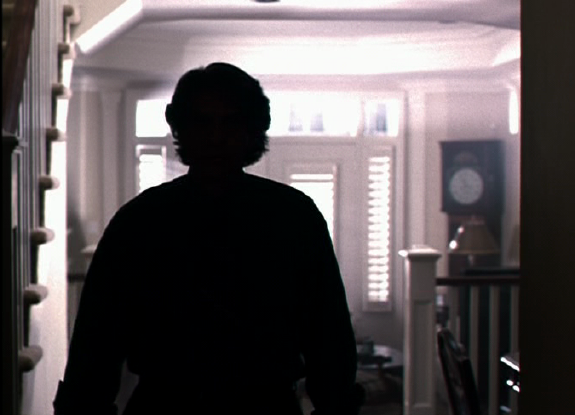
Duncan's assertion isn't very convincing, considering he's backing up as he's saying it. In an amazingly lighting transition, he backs up into a dark silhouette so that the form of his body looks like it was perfectly clipped out of the shot, a Hiroshima shadow burned onto the image denoting something that occupied that space at one point before being forcibly ripped from it. McKellar cuts away before the sound of the gunshot, returning later to the devastating scene of Duncan's eviscerated corpse with TV reports of "no major incidents" playing over it to underscore the insignificance of his murder to the remainder of the world. Duncan's abandoned dairy snack has melted all over the counter in a shot that recalls an earlier moment just before he left the office for the final time and tried a taste of his receptionist Donna's Minute Maid tropical punch, not realizing that she's been habitually spiking it for the last ten years. Sipping the Minute Maid and finding it bitter is Duncan's most unguarded moment, allowing himself (albeit incidentally) a personal indulgence in the work environment, even though he can't help making a quip about reporting Donna that causes her to tense up for a second - on any other day, he'd probably do it!
Duncan's message is played on an answering machine once more after his murder, suggesting that McKellar believes that a man's efforts, even in service of something perfunctory, can outlive him. It's a beautiful sentiment easily lost in a strain of beautiful sentiments - McKellar's interconnected narrative is so exquisitely unforced; it makes garbage like the non-Cronenberg Crash and Babel seem even more embarrassing. His casting of Cronenberg is remarkably instinctive: his lengthier, villanious roles in Nightbreed and Blood and Donuts (and later in Jason X) are predicated on his background as a horror director, whereas in this role you never would have thought this was the guy who ordered his effects department to put a talking anus on a typewriter. John Landis figured Cronenberg's voice could put people to sleep; McKellar knew that it could wake people up.
The film's under-two minute trailer (which bizarrely utilizes BTO's "Taking Care of Business" and gives away the fucking ending!) marks the only time Cronenberg's name has been announced as one of the film's stars.
Glasses? Yes
Tie? Yes
Suit/vest? Vest
Shot in Toronto? Yes
Relationship to cast/crew: Several of Last Night's cast - McKellar, Rennie, Sarah Polley, Kirsten Johnson - turned up in Cronenberg's eXistenZ the following year. Jackie Burroughs, the film's recurring crazy street jogger, played Christopher Walken's mom in The Dead Zone. Dead Ringers' Geneviève Bujold is also in the film. Michael Barry, the actor who kills Cronenberg, reunited with Sarah Polley in 2004's Dawn of the Dead, which also featured Cronenberg's Blood & Donuts co-star Justin Louis. The piano piece played by one of the characters was written by Howard Shore, Cronenberg's long-time composer (thanks, Ian Loffill - I never would have known that!)
Cronenberg movie closest to: Cronenberg's line about who's afraid makes you think of one of his most famous lines ("Be afraid - be very afraid"), but the way Last Night moves among the banal lives of different people in their own environment, including that of Rennie's sex maniac, recalls the ill-fated residents of Starliner Towers in Shivers, which ends with mundane apocalyptic implications. Co-star Sandra Oh has appeared on the cover of Canadian general interest magazine Saturday Night, the pages of which hosted Robert Fulford's infamous decrying of the tax shelter-funded Shivers, "You Should Know How Bad This Movie Is, You Paid for It." (Also I believe both films were filmed under the working title Orgy of the Blood Parasites.)
I'd add that the film's furtive glances at society casually falling apart at the seams appears to have influenced the way Cronenberg shoots the chaos outside Robert Pattinson's limousine, but to imply that Cosmopolis has any of Last Night's undemanding insight into city life or shares its genuine interest in human interaction wouldn't be fair to either film.
The same year, Cronenberg appeared as a psychiatrist in another Canadian film called The Grace of God, another one I couldn't get a hold of. Hopefully his shrink was more helpful to that film's lead character than he was to Boone in Nightbreed.
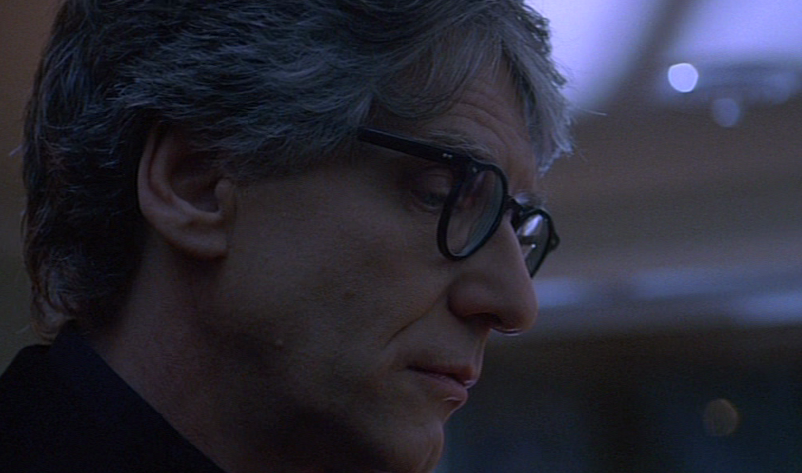
RESURRECTION
russell mulcahy, 1999.
"Father Rousell"
In 1999, Russell Mulcahy reunited with Christopher Lambert for their only non-Highlander joint venture Resurrection, which so far as I can tell is the only Easter-based horror movie of note. I guess Critters 2 and Dead Snow would technically count, although they're just set at Easter time and aren't centered around it. Overall, I'd say Easter is one of the more neglected holidays to be depicted in films not set in Calvary in 33 A.D., its most famous contemporary representation arguably being when Jay and Silent Bob kicked the shit out of the Easter Bunny in Mallrats.
Whatever this movie's villain decided to give up for Lent, it probably wasn't mutilation: he spends the weeks leading up to Good Friday collecting body parts from victims, with which he intends to build his very own Cruicifed Savior ("Christ suffered on the cross - he wants his victims to suffer!") For rare public appearances he wears a faceless mask not unlike Cronenberg's burlap cover in Nightbreed, so when the filmmaker shows up as a Catholic priest from Lambert's past it's tempting to suspect he might be the one behind the unholy amputations until you realize it's too much a coincidence even for the writer of Body of Evidence. No, it's obviously the gaunt FBI profiler who offers his services to Lambert's Cajun cop yet is markedly missing a partner - jeez, didn't this dude see Die Hard? We all know supporting character feds come in pairs, who do you think you're fooling?
Most of the running time is devoted to the usual cop/killer/cat & mouse cliches: the noble hero who's struggling to get over a dead loved one, the angry chief who wants to pull him off the case (but who's really off HIS case - stupid chief!), the partner who gets put out of commission by the end of the second act, etc. But really Resurrection is a low budget Se7en, with an untraceable religion-themed serial killer who leaves no fingerprints! and is always ten steps ahead of those trying to stop him. Lucky for Lambert, this killer's more incompetent than Kevin Spacey: he comes after the hero's wife too, but accidentally kills the wrong lady (luckily he doesn't try the whole head delivery thing - it would have been awkward when Lambert opened the box and said, "Who's that??") Leland Orser, Lambert's partner, even played the traumatized wearer of the "knife dildo" in Fincher's film. He's spared such anguish this time, receiving instead the Dirty Harry Part 1 honor of merely being horribly maimed.
Like Fincher, Mulcahy's a former music video director yet for the most part doesn't over-stylize his serial killer thriller. What he does do is use some really bad handheld camera shots during scenes that don't benefit from being jarring or disorienting. It's bad enough when that kind of thing is done to highlight intensity - applied to two guys walking briskly down the street it just looks like bad filmmaking; more than once, I honestly thought the cameraman had slipped. This stylistic fumble doesn't do much to spice up the standard thriller, although it does feature a memorable climax in which the bad guy makes his way up to the hospital roof and dangles a newborn baby over the ledge in the pouring rain (pre-dating the Michael Jackson scandal by three years). There's also a scene where Lambert and Orser enter a crime scene centered around a decapitated body that made me realize something - when you think about it, the Highlander is pretty much a serial killer. He goes around town cutting off strangers' heads and getting off on it - any of this Easter Killer's trophies could very well come from one of Connor McCloud's "victims." There should be Mulcahy Super-Movie where Lamberton's cop from this one teams up with Denzel from Ricochet, the Real McCoy and the Shadow to take down the Highlander. Also the Razorback. With music by Duran Duran.
Cronenberg is basically the Bugenhagen, the Omen-esque religious background advisor who Lambert rebuffs when he stops by the house to offer solace over his dead son (the victim of a car accident in an unintentionally funny flashback) yet seeks when he needs quick footnotes on biblical references. Cronenberg's got the inside scoop on James and John, the sons of Zebedee nicknamed the "Boanerges" (sons of thunder), which leads Lambert to realize the victims all share names with the apostles, although I honestly can't remember if this information helps him stop the killer. Religion's something that's been largely absent from Cronenberg's catalog, Vaughan's cult of car wreck hedonists being about as close as he ever came to commenting on the subject. Yet he's credible as a guy who knows his way around Mark 3:17, smartly underplaying his part without drawing too much attention to himself, which is more than can be said for The Dead Zone author Stephen King's cameo as a priest in Pet Sematary.
Lambert's great as always. My favorite part of the movie is when he arrives at the end of a co-worker explaining how a friend of his was hit by a bus and laughs, thinking it's the punchline of a joke.
Glasses? Yes
Tie? No - priest collar
Suit/vest? No
Shot in Toronto? Yes (also New Orleans)
Relationship to cast/crew: Like Cronenberg, Russell Mulcahy was briefly courted to direct Total Recall. Robert Joy, who plays the killer, was Gary Farmer's brother/autistic kid's dad in Henry & Verlin. The ball-busting captain, Peter MacNeill, was Jayne Mansfield-obsessed Colin Seagrave in Crash and Sheriff Sam Carney in A History of Violence (he also had a small part in Rabid).
Cronenberg movie closest to: The Frank Dodd subplot of The Dead Zone, in which Chris Walken's Johnny Smith reluctantly lends his psychic powers to the local law enforcement in order to stop a serial killer who turns out to have been one of the cops all along.
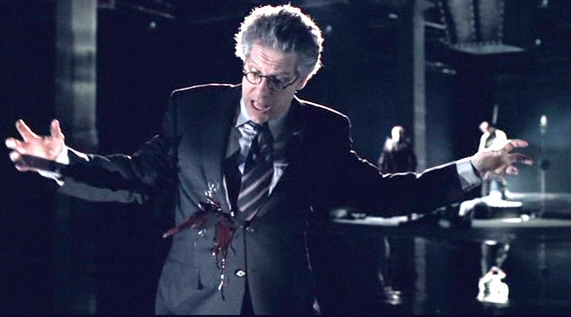
JASON X
james isaac, 2001.
"Dr. Wimmer"
I discussed Jason Voorhees: Space Slasher extensively here, which you should read now while I'm busy reading this racing form.
Just a few more brief words on Cronenberg's brief appearance at the beginning of this movie. For those keeping track, this marks the third time Cronenberg is killed on screen, dying along with six military guys after being impaled midriff by Jason with a steel javelin (SPOILER for the first 10 minutes of the movie). He's been killed by a Nightbreed, a vampire and Jason Voorhees - we've never seen him get killed by a living human being, since only his dead body is shown in Last Night. Apparently to have a chance at killing Cronenberg without the camera cutting away, you have to have died and been brought back to life, although ironically he doesn't get killed in Resurrection. His own resurrection at the end of Nightbreed suggests that Dr. Decker will become a Jason-like slasher zombie - it's too bad Nightbreed's franchise prospects were quashed by bad box office and UberJason's bloodsoaked adventures in the 25th century continued only in comics and spin-off YA novels, otherwise there may have been crossover potential.
Of all the directors who've been killed in horror movie cameos - Jonathan Demme in The Incredible Melting Man, John Waters in Seed of Chucky - Cronenberg's demise is the most astral. Which isn't to say he's actually killed in space, as he dies in the present day (and I think on Earth, although it's not made absolutely clear). His scene's very X-Filesy, from the steely-blue lighting*** ** to the large empty warehouse-type room and the secret government sci fi experiment shenanigans. He's sort of the Cigarette Smoking Man of the group, taking charge of this enterprise to discover the secret of Jason Voorhees' reanimation only to bite off more than he can chew in the form of a tall steel javelin he got in the way of. It's funny watching him run with those giant shoulder pads under his coat, and he pulls off the shocked expression very well. Thanks for showing up, Dave.
As I mentioned in our Horror Space Sequels article, Cronenberg directed a 1987 episode of the Voorhees-less Friday the 13th (technically called Friday's Curse in Canada). Titled "Faith Healer," it deals with a televangelist whose lame tricks are debunked by Robert A. Silverman, who also popped up in Jason X and, through appearances in Rabid, The Brood, Scanners, Naked Lunch and eXistenZ (as D'aaarcy Naaaaderrrrrrrrr), can lay claim to the crown of "staple Cronenberg character actor." But the con artist comes upon a magic glove that gives him the power to cure people's afflictions for real - his first "heal" is none other than Lynne Gorman, Masha from Videodrome - although unfortunately he's then forced to transfer the malady to a third party, horribly deforming and killing them in the process. It's an involving enough episode, for what it is, and a worthwhile way for Cronenberg to spend his time between time masterpieces The Fly and Dead Ringers.
Glasses? Yes
Tie? Yes
Suit/vest? Suit
Shot in Toronto? Yes
Relationship to cast/crew: Isaac, who worked on creature effects for The Fly, was "project supervisor" on Naked Lunch and provided special effects for eXistenZ, apparently cited Cronenberg as his "mentor and idol." Jonathan Potts, who plays Professor Lowe, was a cop in Resurrection.
Cronenberg movie closest to: Cronenberg has yet to set a movie in space. The closest he came to directing a franchise sequel was turning down the offer to helm Return of the Jedi.
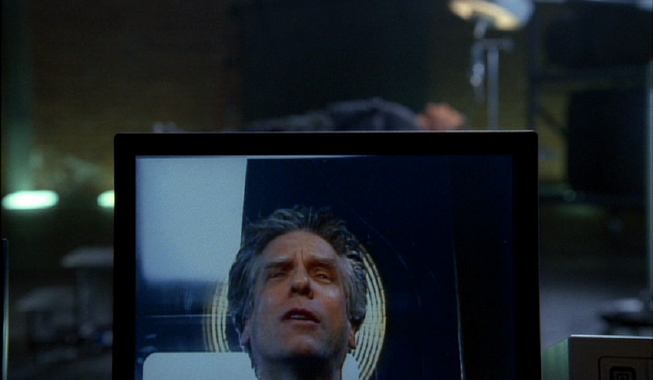
ALIAS
multiple episodes, 2003.
"Dr. Brezzel"
Between The Fly and A History of Violence, Cronenberg didn't direct a single movie that cracked $10 million at the box office. This may explain the large number of acting gigs in the early 90's - the man had to supplement his income somehow - and why he hasn't turned up in nearly as many roles since History's success. In the time since, Cronenberg has stuck mostly to television: he played a detective in the TV movie The Judge in 2001, appeared on something called Happy Town in 2010 and had a supporting role in the time travel TV movie Rewind last year.
Alias was the first real TV disappointment of my adult life. The first two seasons were lots of fun: double agents, fancy disguises, exotic locations, dubious villains, mystic artifacts (part of a mythology that would become progressively oblique and convoluted as the series progressed, not surprising given what we now know about LOST) and a pre-fame Bradley Cooper being beaten in almost every episode. In the middle of the second season, an episode that aired right after the Bucs' #1 ranked defense held off Oakland's #1 ranked offense in Super Bowl XXXVII (Gruden's revenge game) shook up the entire series. In a sleek 40 minutes, "Phase One" blew the she-spy's cover, shut down the criminal syndicate where all the central action took place, killed off a beloved character and replaced her with an evil doppleganger - it was the ballsiest move I've ever seen on a conventionally structured television series. Of course this was before the name J.J. Abrams meant "run for the fucking hills" - back then he was still just the co-writer of Gone Fishin'. Ultimately the show couldn't sustain such a radical revision: after a promising first half, the third season limped to an anticlimactic conclusion like a squirrel that had barely survived being run over by a humvee. The fourth and fifth seasons were so bad I couldn't even tell what the hell was happening. There's a lesson about writing checks your series can't cash - Alias couldn't cash in on the boldness of "Phase One."
Cronenberg showed up right about the time the show peaked; I haven't bothered to pinpoint its decline, but it had to have been some time right after his guest shot. Although the third season suffered from losing Lena Olin's Irina Derevko, the show's best character, it set up an interesting antagonist in Melissa George's insidious double agent Lauren Reed (a part that Katherine Heigl had unsuccessfully auditioned for). George had made memorable appearances in silent yet pivotal film roles, playing Wilson's dead daughter in The Limey*** *** and "This is the Girl" girl Camilla Rhodes in Mulholland Dr., and has gone on to headline such above-average thrillers as Triangle and A Lonely Place to Die as well as enjoyable-if-disposable horror movies The Amityville Horror, 30 Days of Night and Turistas Go Home. The character was promising, but it quickly became apparent that beyond revealing her as a bad guy (SPOILER from 12 years ago) the show had nothing for her to do other than keep the its two leading lovebirds apart. She was mostly relegated to a few cold-blooded assassinations while the season's central mystery - what happened to heroine Jennifer Garner during a two year period that she was missing and believed dead - played out. Since Garner has no memory of what happened to her, they set up an appointment with controversial neuroscientist David Cronenberg.
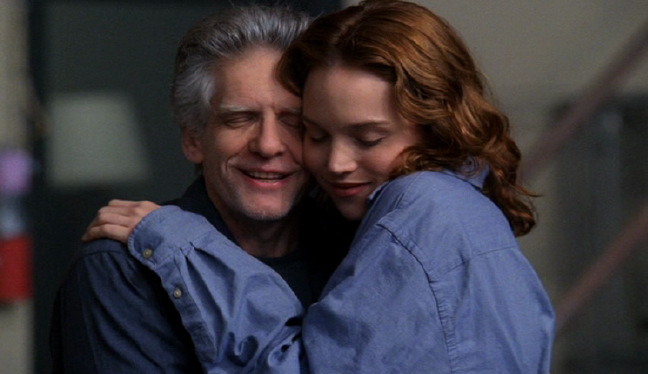
Combining the Timothy Leary hippy drug guru with the amorous college professor, Cronenberg's Dr. Brezzel is living the high life in a secluded laboratory with frequently pantsless guest Kaya, a friendly student of his who "likes to hug." Having her clinging to him is a lot like the floozie he's got attached to his arm in his Trial by Jury scene, although this is the first time we've seen a Cronenberg-depicted character show any kind of obvious romantic interest in someone else (unless you believe Jodorowsky and want to count Craig Sheffer in Nightbreed). It's nice seeing him knee-deep in undergrad "appreciation" and tripping balls - we haven't seen him smile this much since To Die For (even though Victor Garber, Garner's very loving father, instantly disapproves and is repulsed by him). Like Robert Silverman's reclusive scanner, Brezzel is an eccentric artist and expert in an abstract field of pseudo-science magic he terms "memory retrival." After 18 months in traction following an MVA, the head trauma inspired the idea that "dreams are both a priori and a posteriori, dreams contain our memories, a shared reservoir" and that it was possible to consciously enter the subconscious since the mind can still establish transhistorical accounts of the real world through other senses. Mixing a synthetic and organic "cocktail" to convince the brain that it's experiencing the dream/memory, he hooks Garner to the monitor in order to put her "in beta" so she can retrieve the lost two years of her life, adding that there's a slight chance the waking dream might kill her.
What follows is...not worth detailing. 20 minutes of "trippy tv dream sequence" that doesn't even slightly resemble an actual dream. In other words, once Cronenberg's out of the episode it's pretty useless even though he provides occasional voice-over, coaching Garner during her dream state. While he's around there's plenty to enjoy, especially his enthusiasm for bacon (Canadian bacon?) This case of the munchies is even thematic, as he holds up the grizzled strips of "fake-on" (Canadian fake-on?) and explains that "We live in an age of simulations." I love a good food-based performance; he also snacks on barbeque chips while monitoring Garner's brain waves or whatever.
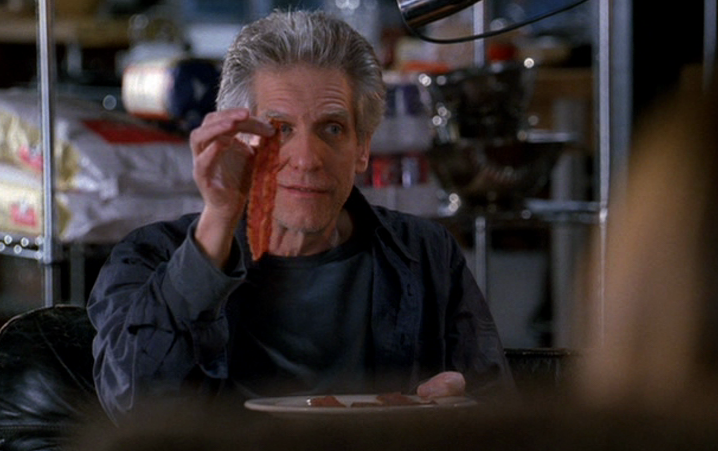
Cronenberg must have felt comfortable in this role since he spends most of the time giving Garner direction. The actual director of the episode describes Cronenberg as "subtly idosyncratic," was impressed by how quickly he learned the dialogue (basically the day before shooting) and how good he is at extrapolating (eXtrapolaTing?) and states the veteran filmmaker "wasn't the least bit interested in the directing," just there to do his part. And he does a really good job: this may be the deepest Cronenberg's ever gone into a performance. He's obviously having fun with the stoner comedy, but brings some serious intensity when things go wrong with Garner's treatment and her expertly revives her after putting her into v-tach. He gives it his all in his death scene the following episode, having been tracked down by evil henchman Mr. Sark and given so much morphine he basically trips to death, his eyes wide open in horror/ecstasy (which brings the number of times Cronenberg's been killed on screen to four, the times he's been murdered totaling five).
Cronenberg wasn't the first film director to appear on the show: Tarantino showed up in the first and third seasons to offer his typical rambling mental patient performance. Before it jumped the shark, Alias featured an inspired line of guest appearances and recurring actors including Terry O'Quinn, Gina Torres, Roger Moore, Richard Roundtree, Rutger Hauer, Isabella Rossellini, Griffin Dunne, Vivica A. Fox, Djimon Hounsou, Justin Theroux and Angus Scrimm. Even Richard Lewis and Ricky Gervais managed to be intimidating - they seem to have reversed that bit of stunt casting with Cronenberg, making him as unintimidating and indeed as goofy as possible. His freaky/creepy presence is typically what motivates his casting, so I have to give them credit there. Speaking of which, I can't believe Cronenberg hasn't turned up on Hannibal yet - it even shoots in Toronto, which suggests that either he's not interested in appearing on the show or they're waiting to offer him a really choice role.
Glasses? No
Tie? No
Suit/vest? No - pajamas!
Shot in Toronto? As far as I can tell the production was set in California
Relationship to cast/crew: Only that both Cronenberg and J.J. Abrams were offered the chance to direct a Star Wars movie - one said yes, the other said no. Abrams also got blurbed on the back of Cronenberg's new novel, issuing the recommendation/warning that "Consumed will, well, consume you."
Cronenberg movie closest to: The producers of the show probably thought of Cronenberg because of eXistenZ, his most recent film, in which players are neurologically linked to a set reality. But his cheery brain scientist reminds me of the grinning Barry Convex when he sets James Woods up with the Image Accumulator helmet at Spectacular Optical (or rather, sets Cronenberg up with the Image Accumulator helmet at Spectacular Optical), but before he shoves a pulsating video tape into Woods' hungry abdominal gash.
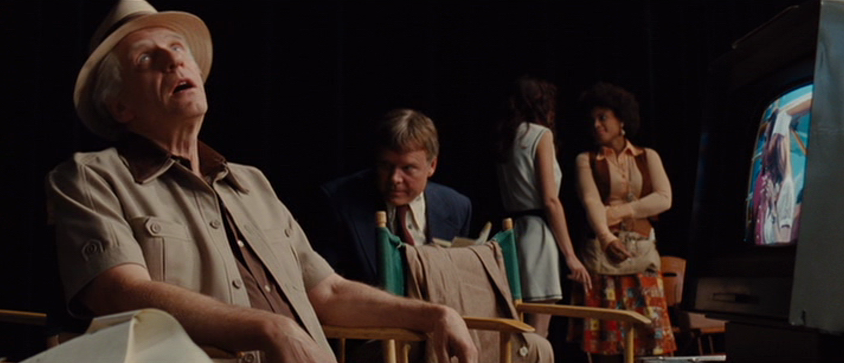
BARNEY'S VERSION
richard j. lewis, 2010.
"O'Malley director #2"
Did you hear that Brett Ratner has signed on to remake March of the Anal Sadistic Warrior? Apparently he's got ideas about how Ben Stiller and Chris Tucker can add the missing ingredients to Matthew Barney's oblique experimental short film centered around fashion and performance art. I'm sure it will be fine, but ultimately I'll probably end up preferring Barney's version.
Oof - I'm winded from that gag. Let's move on. Internationally renowned Canadian directors flocked to the set of the first posthumous film taken from the work of Mordecai Richler, sort of the Philip Roth of the Great North whose The Apprenticeship of Duddy Kravitz (co-starring Joe Silver from Shivers and Rabid) and Joshua Then and Now (starring Videodrome's James Woods) were made into critically revered films by Ted Kotcheff. Kotcheff was a close friend and former housemate of Richler's, who also co-wrote the script for Kotcheff's film Fun with Dick and Jane. I had just assumed Kotcheff was Australian because of Wake in Fright, but it turns out he's a Macedonian Bulgarian born and raised in Toronto (good thing I found that out just before finishing my in-depth Ted Kotcheff biography!) In Barney's Version, Kotcheff plays a train conducter, possibly in tribute to that fateful train Gary Bond should never have gotten off in Wake in Fright.
Barney's Version was directed by Richard J. Lewis, whose previous film was K-9: P.I. (not to be confused with K-2 or K-19: The Widowmaker). Now I know, some of you might scoff at a DTV sequel to K-9. Some of you might not think it lived up to the reputation of the first DTV sequel to K-9, K-911. But both sequels were written by Gary Scott Thompson, alias Randy Scott Knobson, creator of the Fast and Furious franchise (as well as such DTV sequel classics as Timecop 2: The Berlin Decision).**** *** If you ask me, the producers should have played up GST's involvement, calling the movie K-9: Fast and Furry-ious. For his part, Richard J. Lewis not only directed K-9: P.I., he also played acoustic guitar on the soundtrack. So he's sort of like Satyajit Ray in that respect, contributing to the music for the films he directs.
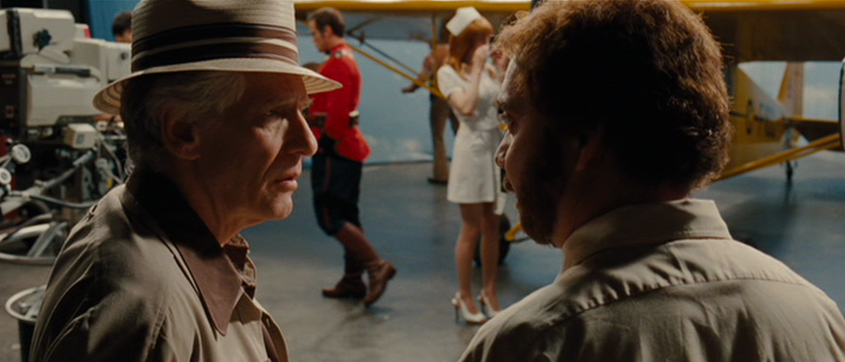
Paul Giamatti of Thunderpants fame plays a putz who produces a soap opera, so David Cronenberg gets his second role as a director. Compared to the slick hot shot from Trial by Jury, here he's almost blasphemously clad in khaki and robbed of his trademark glasses, making him look older than ever. Atom Egoyan and Denys Arcand both appear looking like themselves, I don't know why Mr. K-9: P.I. felt like he had to pick on Cronenberg. But his scene's actually pretty funny - he's directing a cheesy love scene shot against an extremely phony airport background and has fallen asleep in the middle of a take, snapping out of it just in time to call "cut." Then he's confused as to why the actress is crying her eyes out after assuring a mountie that, "My airstrip is open to you anytime"; Giamatti reminds him that the girl's fiance died in a plane crash, but Cronenberg still doesn't see what the big deal is. (It's surprising that Egoyan and Arcand would show up for this film and not Last Night, which featured cameos from François Girard and Bruce McDonald on top of Cronenberg having a supporting role. Especially Egoyan, considering Sarah Polley, Arsinée Khanjian and McKellar were all involved...I guess it would have been right around the time Sweet Hereafter was stacking up awards and earning him an international reputation.)
Cronenberg's director might come off as insensitive, but every other character in this movie is damn near detestable. Either purposely so, like Minnie Driver's unnamed "second wife," a portrayal so steeped in naggy JAP stereotype it makes Macklemore look sensitive (at times the movie flirts with full-blown misogyny), or inadvertently, as is the case with Scott Speedman's annoyingly "liberated" curly-haired rogue of a best friend. As for Barney, he's just a hunched, unkempt, cigar-clutching sad sack of self-loathing, the worst embodiment of a "Giamatti-esque" character, and the movie dares you to hate him without realizing how easy it is. Even though he ditches his loving bride on their wedding day to catch Rosamund Pike at the train station and tell her he loves her before she's a gone girl, the movie treats it with "That's our Barney!" sentimentality. There's a subplot about him possibly murdering Speedman that's promising until it becomes obvious that Barney's innocent, so most of the two hour running time we're left with our hero acting like a world class schnook.
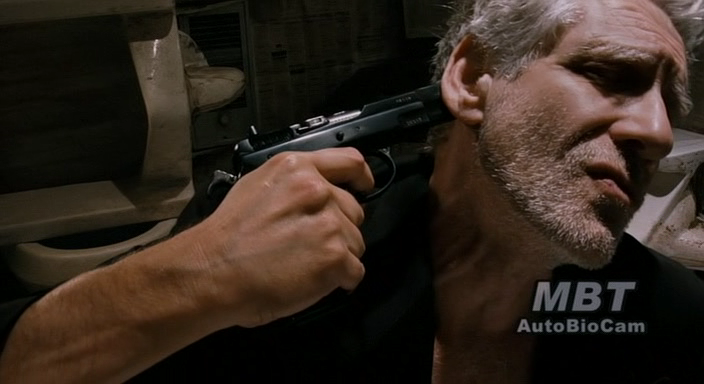
Other than offering homage to Richler, that esteemed Québécois man of letters, I wonder if an older Cronenberg was starting to feel an obligation towards his Jewish lineage. The year before had made the single-shot short film "At the Suicide of the Last Jew in the World in the Last Cinema in the World" for the anthology To Each His Own Cinema, casting himself as the unshaven, suicidal "last jew." The four-minute short has bearded Cronenberg sitting on a toilet in the bathroom of a run-down theater in front of an "AutoBio Cam" loading a gun and aiming it at different areas of his head as two voices provide sports coverage-type reporting on his imminent suicide. Because of the setting and the subject, it recalls serial killer Frank Dodd's similarly systematic suicide in a bathroom in The Dead Zone, with added ambiguous commentary. We learn from the broadcasters that Cronenberg's Hungarian Jew (he actually comes from a Lithuanian Jewish heritage) "used to work in film" before theaters around the world began disappearing, making rom for "better things," the one he's occupying now functioning for years in secret before being shut down. The unexplained eradication of Jews and cinema seems to be the director's way of lamenting the way films used to be made and how the political changes aren't of his own choosing (the final image makes it look like somebody else is shoving the gun into his mouth). The film came from Cronenberg's reaction after reading about the Hezbollah's mission statement: "It's pretty interesting to hear someone say our goal is to kill every Jew in the world wherever they are. That means me and my children. It does evoke a reaction."
As for Barney's Version, it swept up some Genies including acting awards for Giamatti (who also won a Golden Globe), Hoffman (beating out Callum Keith Rennie, who had previously won for Last Night) and Driver and one for the makeup (which also got an Oscar nomination). Cronenberg's been nominated for 8 directing Genies, winning a record 4.5 times for Dead Ringers, Naked Lunch, Crash, Spider and splitting the win for Videodrome with Bob Clark for A Christmas Story. He's never won a Genie for acting.
Glasses? No
Tie? No
Vest? Yes, but it's khaki
Shot in Toronto? Montreal (with exteriors in Rome and New York)
Relationship to cast/crew: Produced by Robert Lantos, Cronenberg's producer on Crash, eXistenZ and Eastern Promises. Cronenberg would cast star Paul Giamatti (who co-starred with Last Night's Sandra Oh in Sideways) in 2012's Cosmopolis. Atom Egoyan also had a cameo in The Stupids.
Cronenberg movie closest to: The uninteresting "what crime happened in the past?" mystery subplot and flashback structure make it closest to Spider, with the obvious difference being that Spider is an underseen masterpiece while Barney's Version
~ 2015 ~
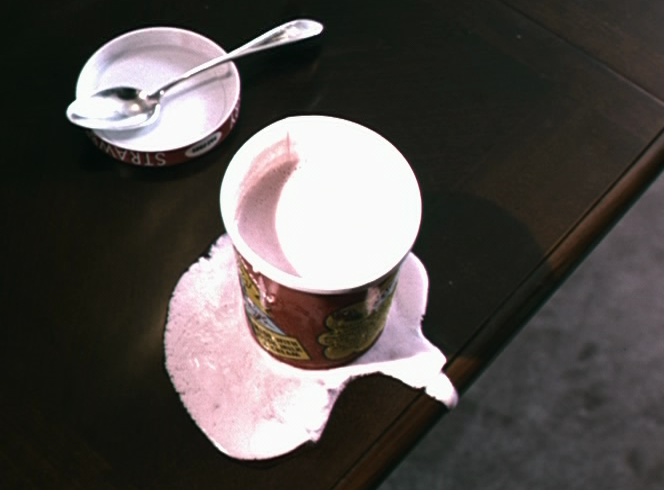
* Heywood Gould also rewrote Paul Schrader's script for Rolling Thunder and wrote & directed the Michael Keaton-starring One Good Cop.
** I've never seen The Juror, but I just read about it and holy shit it is literally the same movie: single mother selected for jury duty in the trial of a vicious crime boss, only to find herself menaced by the mobster's hired goon (Alec Baldwin standing in for William Hurt - funny since Jack Donaghy is such a big fan of The Rural Juror) who expects her to stall the jury and force an acquittal. She successfully gets the gangster off but the prosecutor finds out about it, she sends her son away for his own protection, all the bad guys end up turning on each other and get killed - I'm willing to bet young Joseph Gordon-Lewitt even has a line about his room hugging him. I guess Juror must have had a slightly higher profile, since Demi Moore won a Razzie for her performance. So did Pauly Shore for his turn in Jury Duty. Guess you didn't suck quite enough to be recognized for it, J. Whalley-K.
*** J. Hoberman recently suggested that Robert Silverman's creepy sculptures in Scanners "bring to mind George Segal figures in hospital gowns." He's talking about George Segal the actor... right?
** ** Kidman played famous suicides in The Hours and Fur and tragically succumbed to luhrmannitis in Moulin Rouge.
*** ** Care of Derick V. Underschultz, shooting his only feature. He was a cinematographer for episodes of Robocop, F/X: The Series, Total Recall 2070, Transporter: The Series - apparently the guy just really likes lighting tv shows based on movies.
*** *** Her character's equally sinister mother was played by Peggy Lipton, who in real life was briefly involved with Terence Stamp, George's "dad" from The Limey.
**** *** His wikipedia page also identifies him as writer of the "cult classic" Split Second. Now, Split Second has been a guilty pleasure of mine for over 20 years... however, I'm unaware of any cult surrounding it and have in fact never met a living human being who has any idea what I'm talking about when I start gushing about Split Second. Could a member of this alleged cult please contact me through the Pink Smoke, solongyoubastard@gmail? I want to be initiated into this cult of Split Second worshippers.







































